MARKETING
The Ultimate Guide for Taking Full Control of Your Google Business Profile and NMX

The author’s views are entirely his or her own (excluding the unlikely event of hypnosis) and may not always reflect the views of Moz.
Ready for a deep dive into 40+ common features found on Google Business Profiles (GBPs) and the New Merchant Experience (NMX)? Here we go!
You may feel daunted by the fact that GBPs are major assets you rent from rather than owning because Google has always taken a crowdsourced approach to vital information that represents your company. You may also be disgruntled right now because you had gotten used to managing your listings in the historic Google Business Profile Manager dashboard, like this:
And now Google has ousted you from the familiar dashboard and tossed you into the chilly, unfamiliar pool of in-SERP listings management which we’re calling the New Merchant Experience and which looks like this:
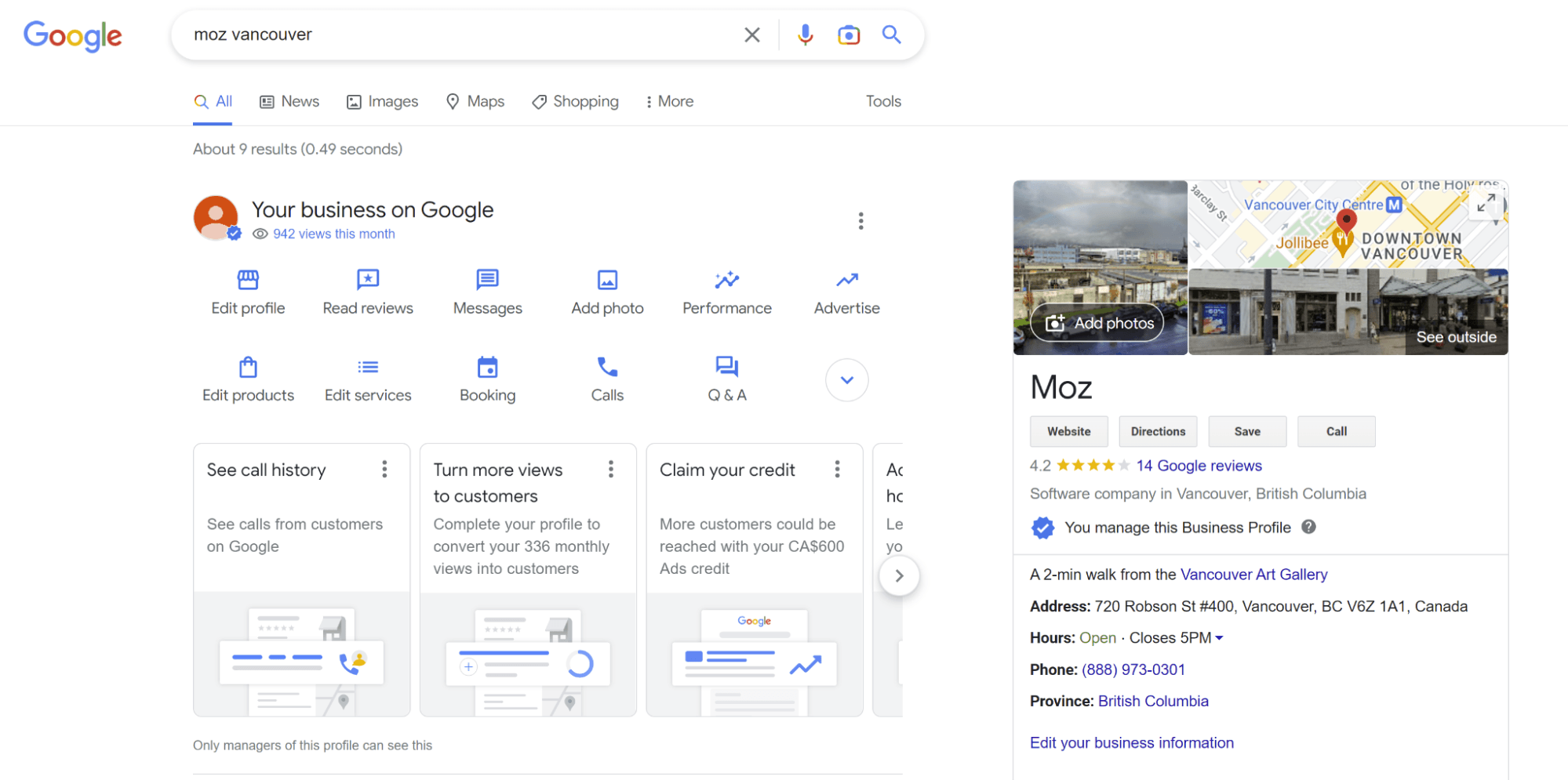
You might rightly remark that major change was the last thing you needed right now as a local business owner or marketer. But, deep down, you know you’re going to have to get the hang of this sometime, and this column is here to help you with that. After all, with estimates as high as 70% – 80% of local business leads happening right within Google’s interface, you can’t ignore GBP. Instead, you’ve got to learn to control every bit of it that you can. This article will take you through the most common features of these listings, explain what you can and can’t control on them, and teach you how to manage controllable features in the NMX.
If, after reading this cheat sheet, you find you just can’t stand the clutter of trying to manage your listings via the NMX amid the crowded organic SERPs, remember that listings management software like Moz Local still offers the niceties of a clean, organized dashboard for those who require a quieter workspace.
Core features on most Google Business Profiles and NMX interfaces
There is significant variation of Google Business Profile and NMX features based on business industry and category. For example, hotel listings have elements that aren’t included in listings for plumbers or grocery stores. Google is continually experimenting with new features while demoting others. This section will cover some of the commonest elements available to most businesses.
Before we look at our graphic and key, it will help you to know that you can access the New Merchant Experience by searching within Google’s organic SERPs for the name of your business, or the name of your business + its city, or for the phrase “my business” while logged into your Google account.

1. See Photos
When clicked on, this takes the user to both owner and user-generated photos in a set. Photos significantly impact CTR. Photos must be monitored for spam. You can also upload videos to your photos section, but try to post more than 2 videos so that you’ll get a separate mobile video subtab. It’s also important to know that previous versions of Google’s local product offered an analytical feature called “Photo Insights” but this no longer exists in the NMX.
Controllable?
Partly — photos are both an owner and crowdsourced element.
Where to control?
By clicking on the “Add Photo” link in the listing or the NMX, you will be taken to the following wizard for uploading different types of photos.

If you wish to view all your photos for the purpose of identifying user-uploaded spam, click on the image, itself, in the listing, rather than the “add photos” link, and you will be taken to the interface where you can both see and flag photos.
2. Maps
When clicked on, this takes the user to the Maps-based listing accompanied by map with pin. Be sure your map marker is correctly placed.
Controllable?
Partly — owner can correct misplaced map marker, but users can submit placement edits, too.
Where to control?
If your map pin is in the wrong place, click on the “Edit Profile” link in the new interface, then click the “Location” tab at the top of the “Business Information” pop-up, then click on the map.
3. See Outside
When clicked on, this takes the public to an interactive Google Street View visual of the business. When you are logged in, clicking on the feature takes you to this interface for uploading your own exterior imagery:
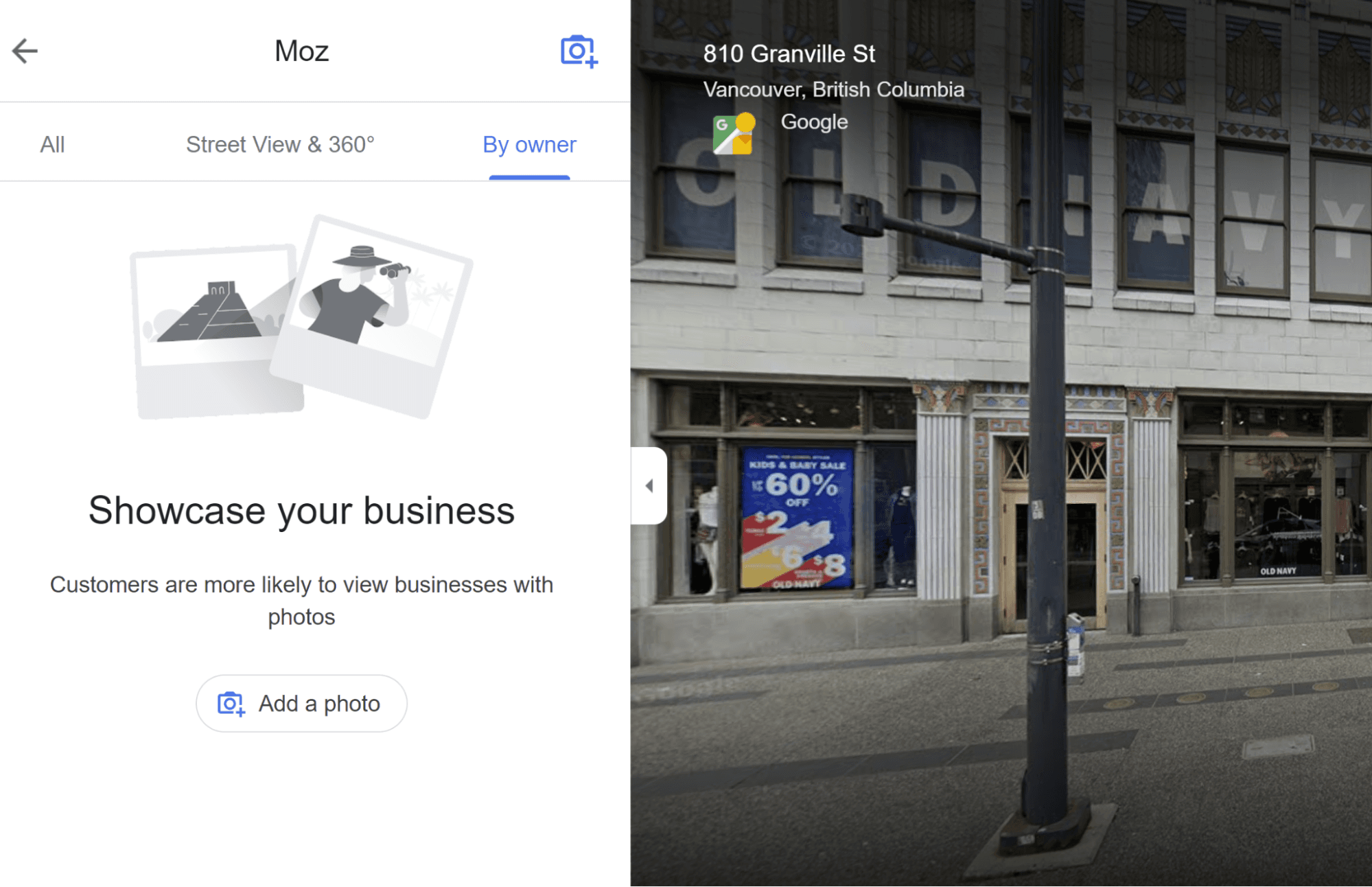
Controllable?
Partly — the owner can upload their own exterior shots, but cannot control StreetView. You can flag issues.
Where to control?
Click on the “see outside” section of the Google Business Profile to upload photos.
4. Business name
This must reflect the real-world name of the business and be formatted according to Google’s guidelines. If you’re marketing a service area business like a plumbing franchise without storefronts, your name should match what appears on your website.
Controllable?
Yes — the business owner provides, though the public can suggest edits to this feature.
Where to control?
In the NMX, click the Edit Profile link and mouse over your name in this popup to edit it in the About section:
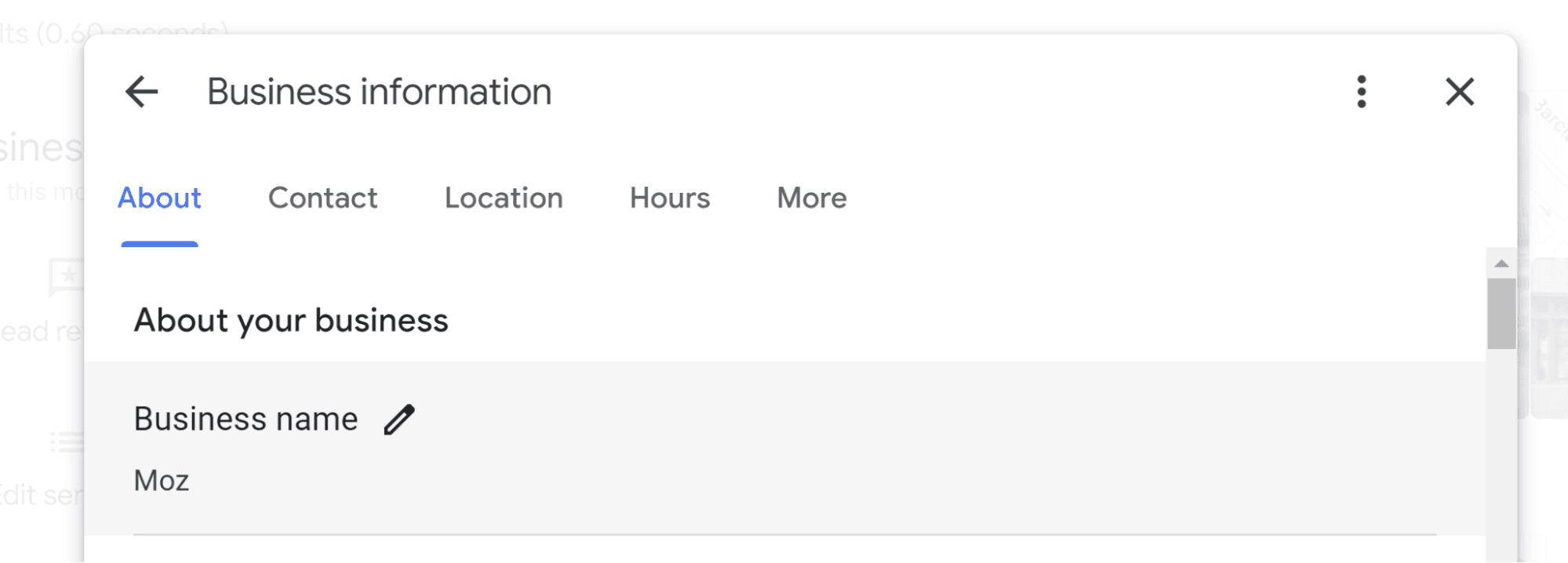
5. Website
This link takes you to whichever page of your website you’ve designated as the Google Business Profile landing page.
Controllable?
Yes — owner provides, though the public can edit.
Where to control?
In the NMX, click the Edit Profile link and mouse over your name in this popup to edit it in the Location section:
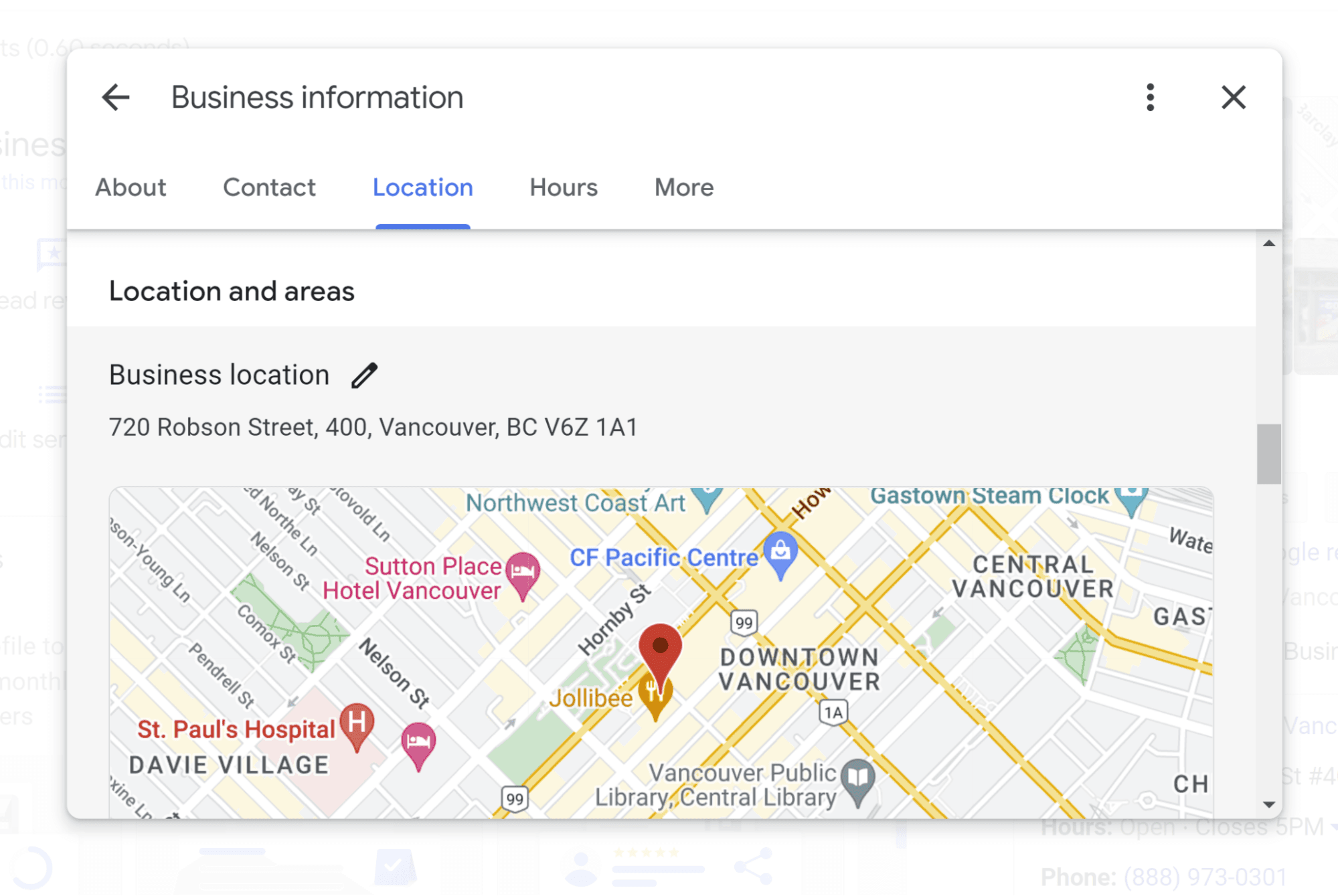
6. Directions
This link takes you to the maps-based driving directions from the user’s location to the place of business.
Controllable?
No. This experience is created by Google. However, see earlier advice if you need to move your map pin.
7. Save

When a user is logged into their Google account, clicking the “Save” button brings up the above pop-up, enabling them to store the business in their favorites or other areas like places they want to go or are planning to travel to.
Controllable?
No — Businesses do not control whether customers utilize the “Save” function.
8. Call
On mobile devices, clicking the “call” button automatically triggers a phone call to the business. On desktop, it brings up this popup asking the user to pick an app with which to start the call.
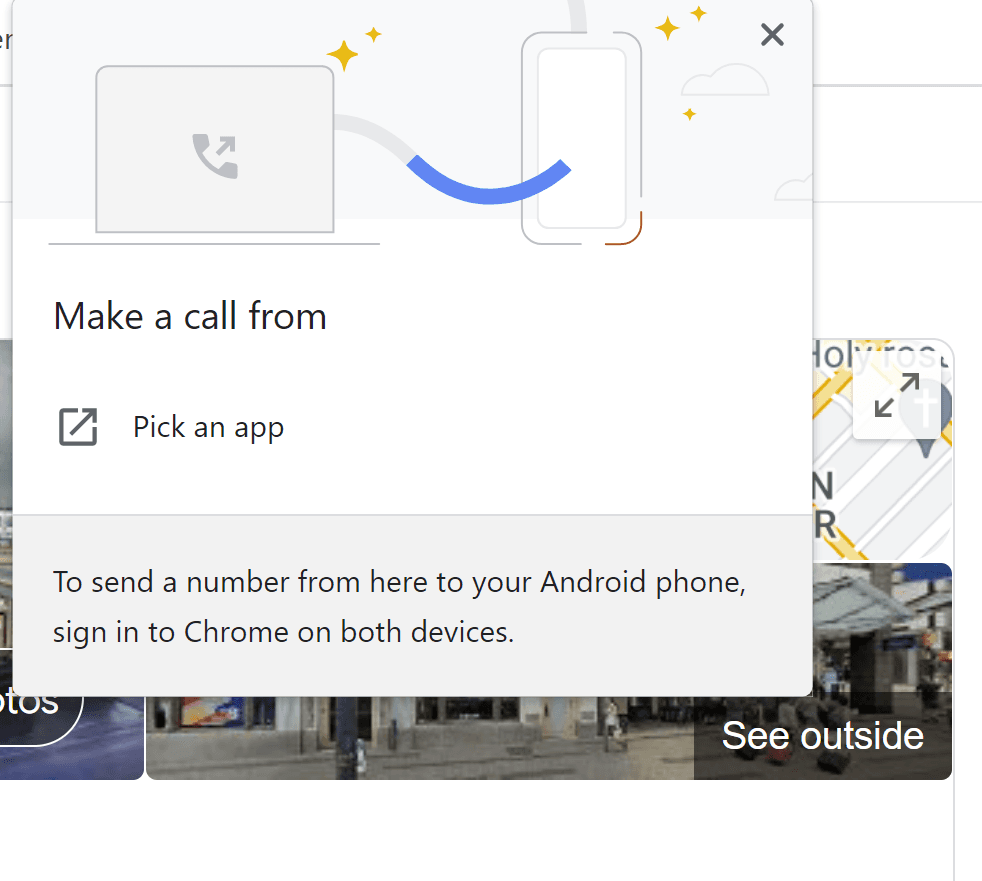
Controllable?
No — beyond ensuring that your phone number is accurate, this is not an area controlled by the business.
9. Star Rating
Google uses a simple mathematical average to calculate the overall rating of a business on the basis of all the star ratings reviewers have given the business. The star rating is considered the #1 review factor that customers use to differentiate one local business from another.
Controllable?
No — businesses cannot directly control or alter the star ratings they receive. Providing excellent customer experiences is the best way to earn the kind of reputation that results in a high Google Business Profile star rating.
10. Review Count
This is a simple count of the total number of Google-based reviews the business has received. Surveys indicate that consumers can become suspicious when any local business has either too few or too many reviews compared to its competitors. When clicked on, the review count takes the user to the main review overlay, which we will cover in full below.
Controllable?
No — the business cannot directly alter the count of its reviews, but can implement a review acquisition program to increase its total number of reviews over time.
11. Editorial Summary
This is one of the more diverse elements of the GBP. In our initial example, a common format is shown of Google taking the primary category and combining it with location information, like this, near the top of the listing:
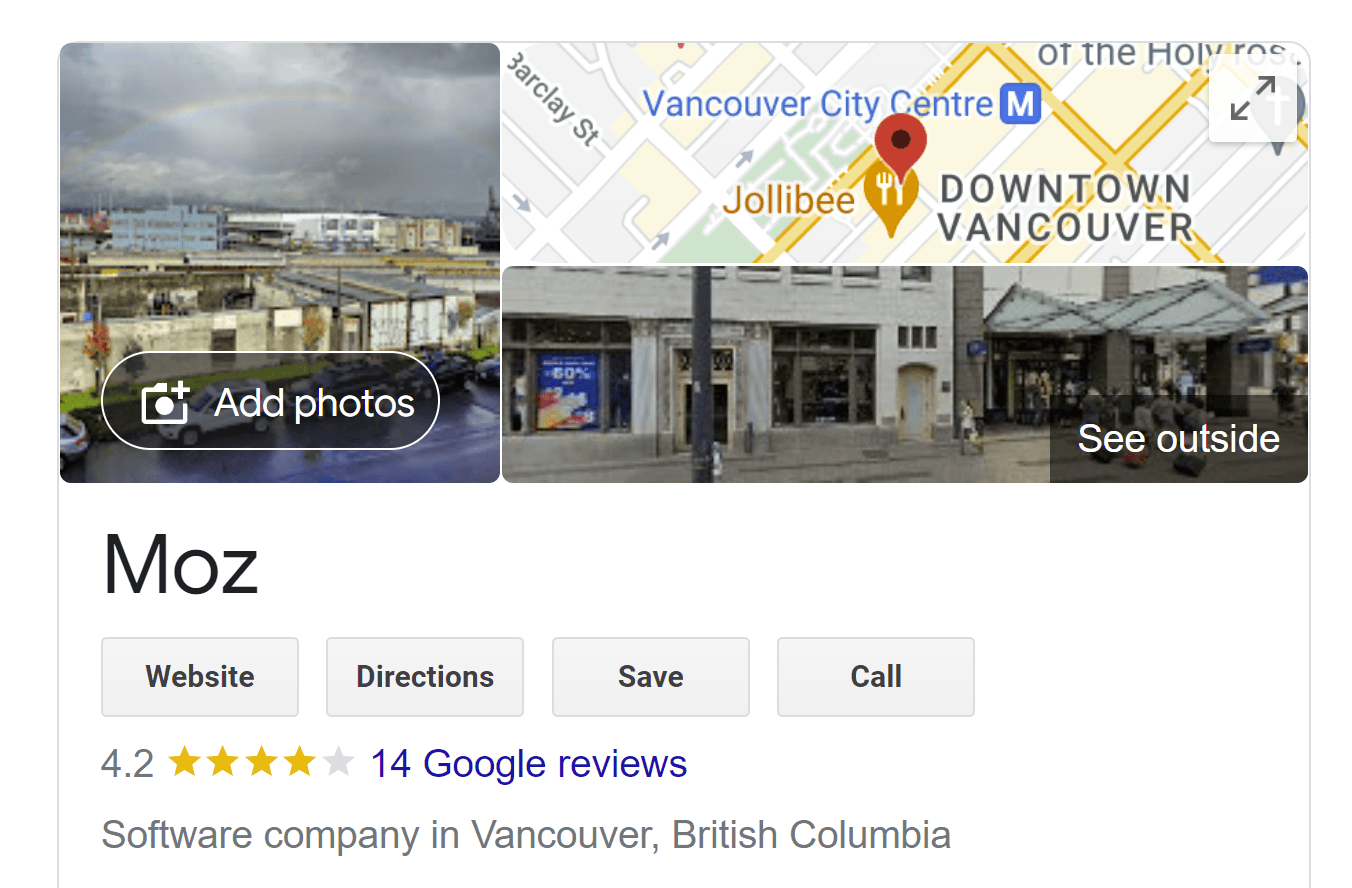
However, other iterations may also be considered editorial summaries, including this example which cites a third party like Wikipedia and may appear further down in the listing:
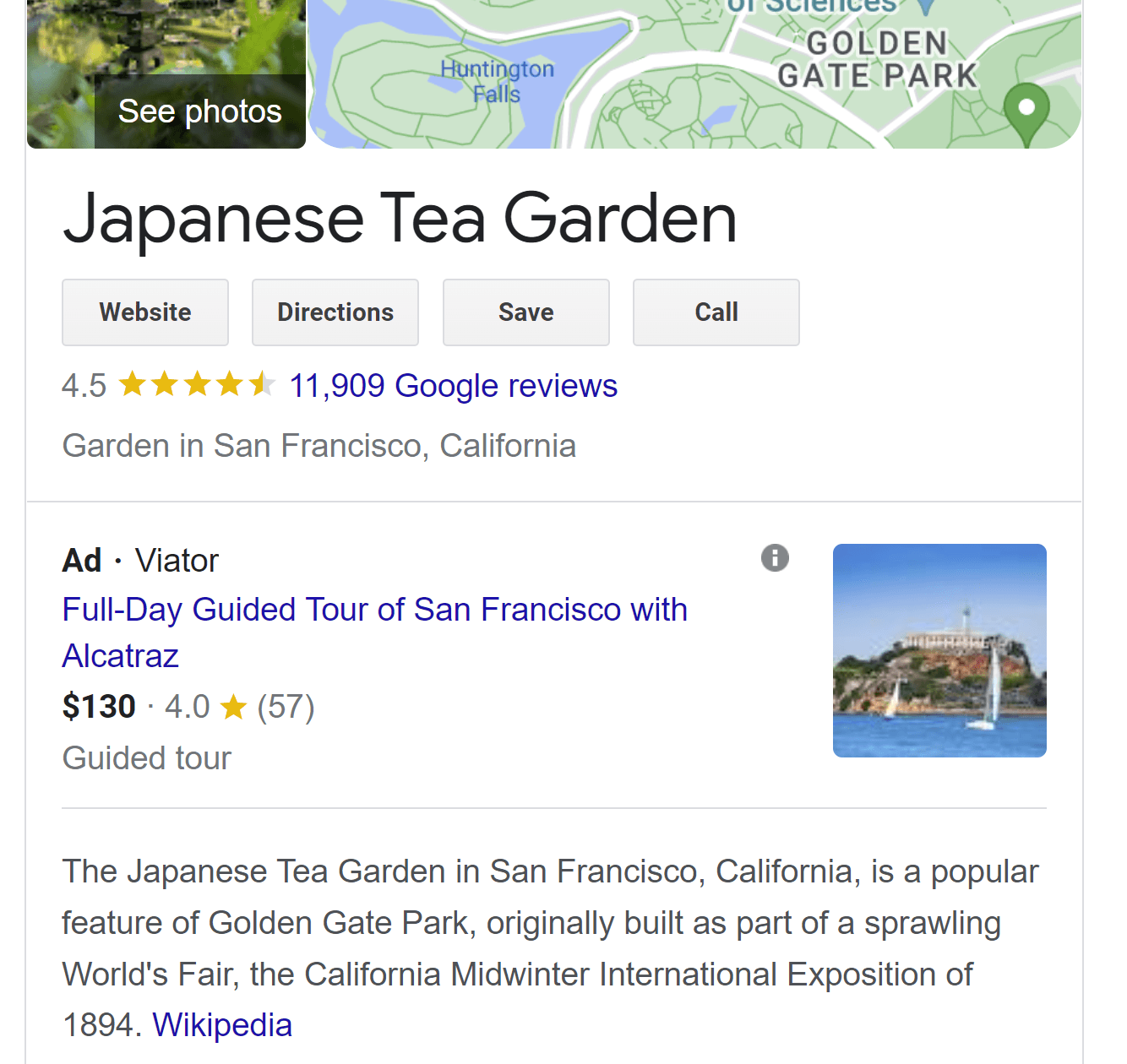
And there is at least one other version that may appear within the reviews section of the listing, specifically cite Google as the originator of the summary, like this:

The nomenclature for these elements is loose, and Google may well have unique internal names for all three instances.
Controllable?
Partly — in the case where the primary category is included in the summary along with location information, the business is contributing the information that yields that summary, and in the case of well-known entities that have control of a Wikipedia page, there would be some editorial control built into the source from which Google is deriving the description, but overall, it is Google who generates these summaries.
12. Further Directional Cues
This is a feature which only appears on some Google Business Profiles. In this example, the user is being given information about the walking distance to nearby major local attractions with embedded links to those venues.
Controllable?
No, but do be sure your map pin is correctly located so that Google can easily identify whether your business is located near to local attractions.
13. Address
For brick-and-mortar businesses, this line must display a genuine, physical address that complies with Google’s extensive guidelines. For service area businesses that don’t serve customers at the company’s premises, Google wants the address to be hidden, and instead of showing a street address, an “area served” section like this will typically be shown:

Controllable?
Yes — brick-and-mortar business owners provide their address, though the public can suggest edits to it. Google has a dedicated page of instructions regarding listing and editing addresses.
Where to control?

From the NMX, click on “Edit Profile” and then the “Location” tab to edit your address. This is also where the toggle is located to hide or display your address.
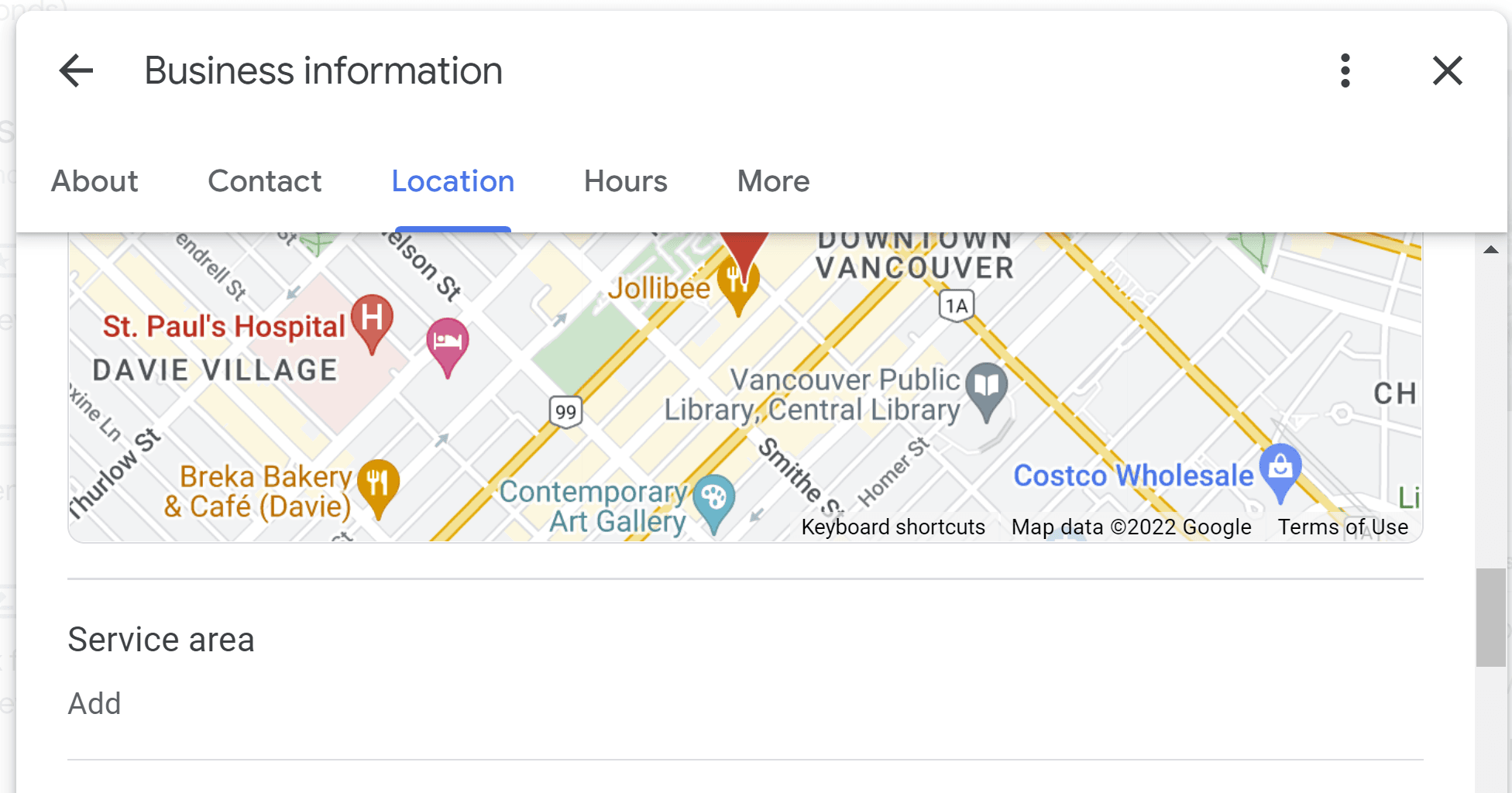
For service area businesses, the place to edit your information is also located in the “Location” tab of the NMX. You can add up to 20 locations describing your service area, but its overall boundaries shouldn’t extend beyond about 2 hours of driving time.
14. Hours of operation
One of the key ways in which Google Business Profiles provide customer service is via the presence of accurate hours of operation. Be sure yours are kept up-to-date at all times, so no customer is inconvenienced by arriving at your premises to be greeted by a “closed” sign.
Controllable?
Yes — businesses add their hours, though the public can edit them. Businesses can also set special hours for holidays.
Where to control?

From the NMX, click on “Edit Profile” and then the “hours” tab to edit your information. You will also find a feature there for adding further special hours:
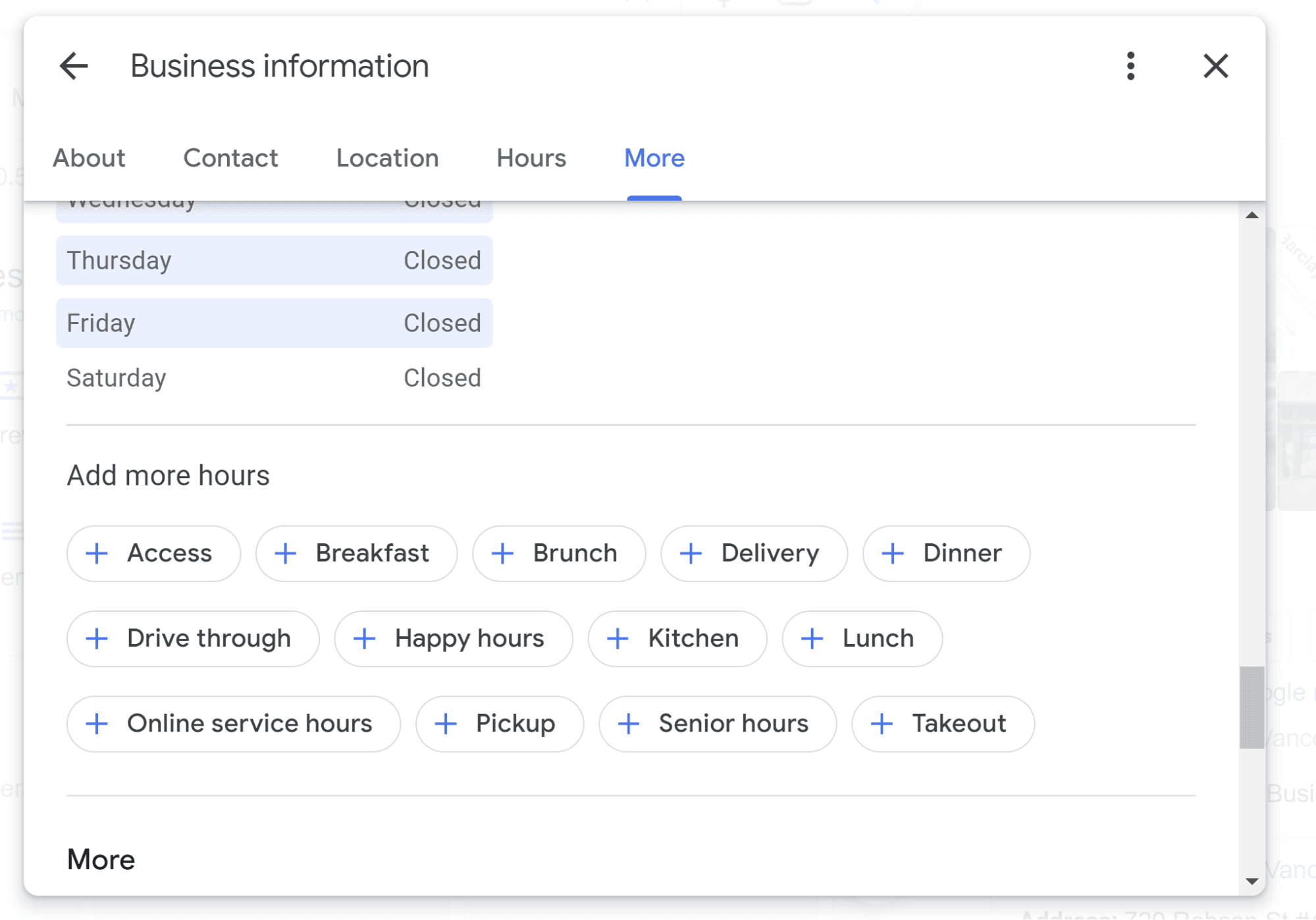
15. Phone
You can add a primary phone numbers and additional phone numbers to your listing. Google prefers that you use a local phone number rather than a call center helpline whenever possible, and they want your listed number to be in the direct control of your business. Your number can be either a landline or cell phone number, and it’s a best practice to be sure that whatever number you list is answered by staff who say the name of the business when they pick up. It’s not a good practice to have more than one business share the same phone number. For example, if you own both a Christmas tree farm and a woodworking studio on the same property and are listing each business separately, each business should have it’s own phone number. Premium-rate telephone numbers that charge callers high rates aren’t allowed.
Controllable? Yes — the business lists their numbers, but the public can suggest edits to them.
Where to control?
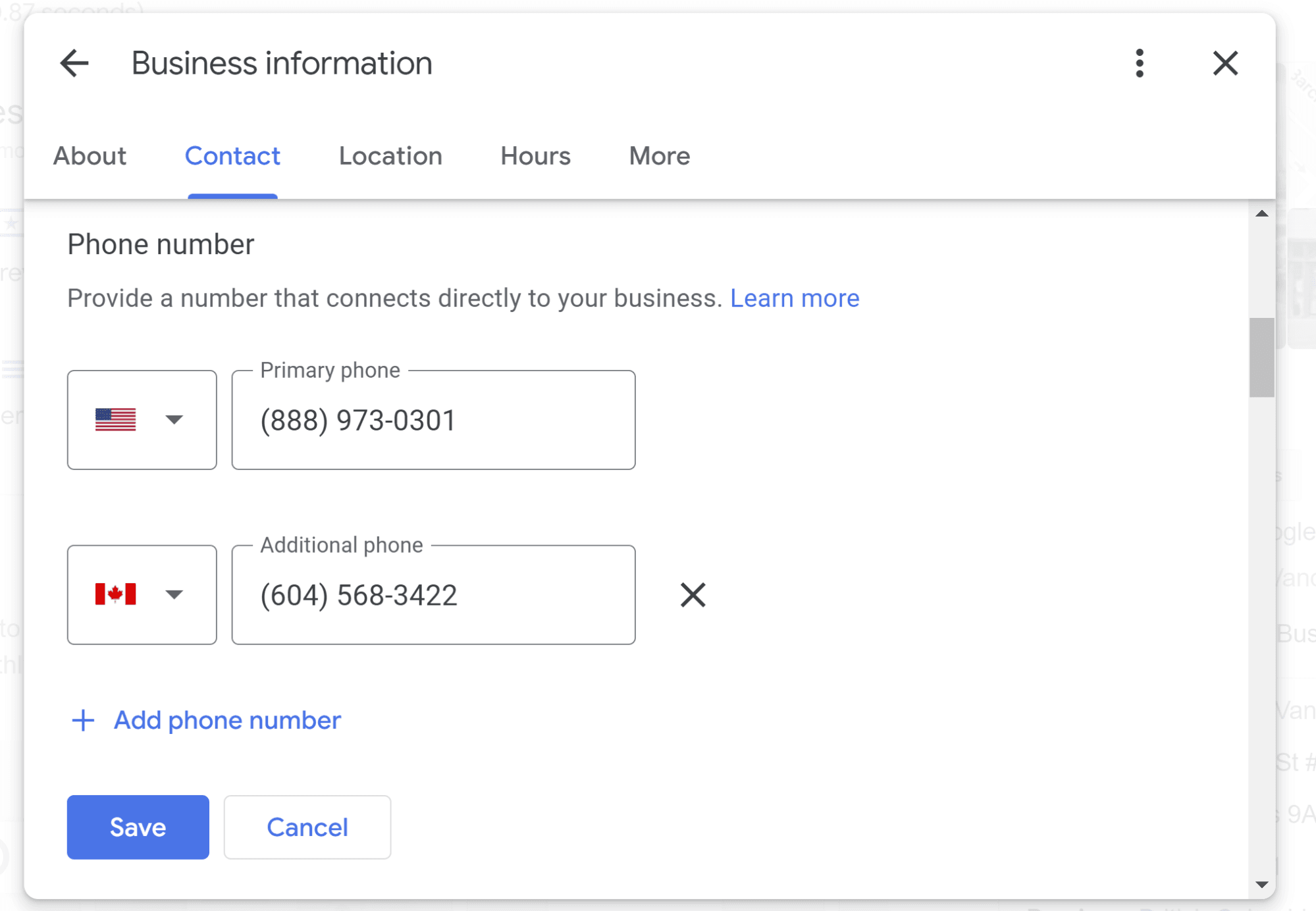
In the NMX, click “Edit Profile” and then “Contact” to see and edit your phone numbers. Related to this, the NMX also has a button labeled “Call”. When clicked on, this button will ask you if you want to enable Google’s call history feature, which you can read more about here:
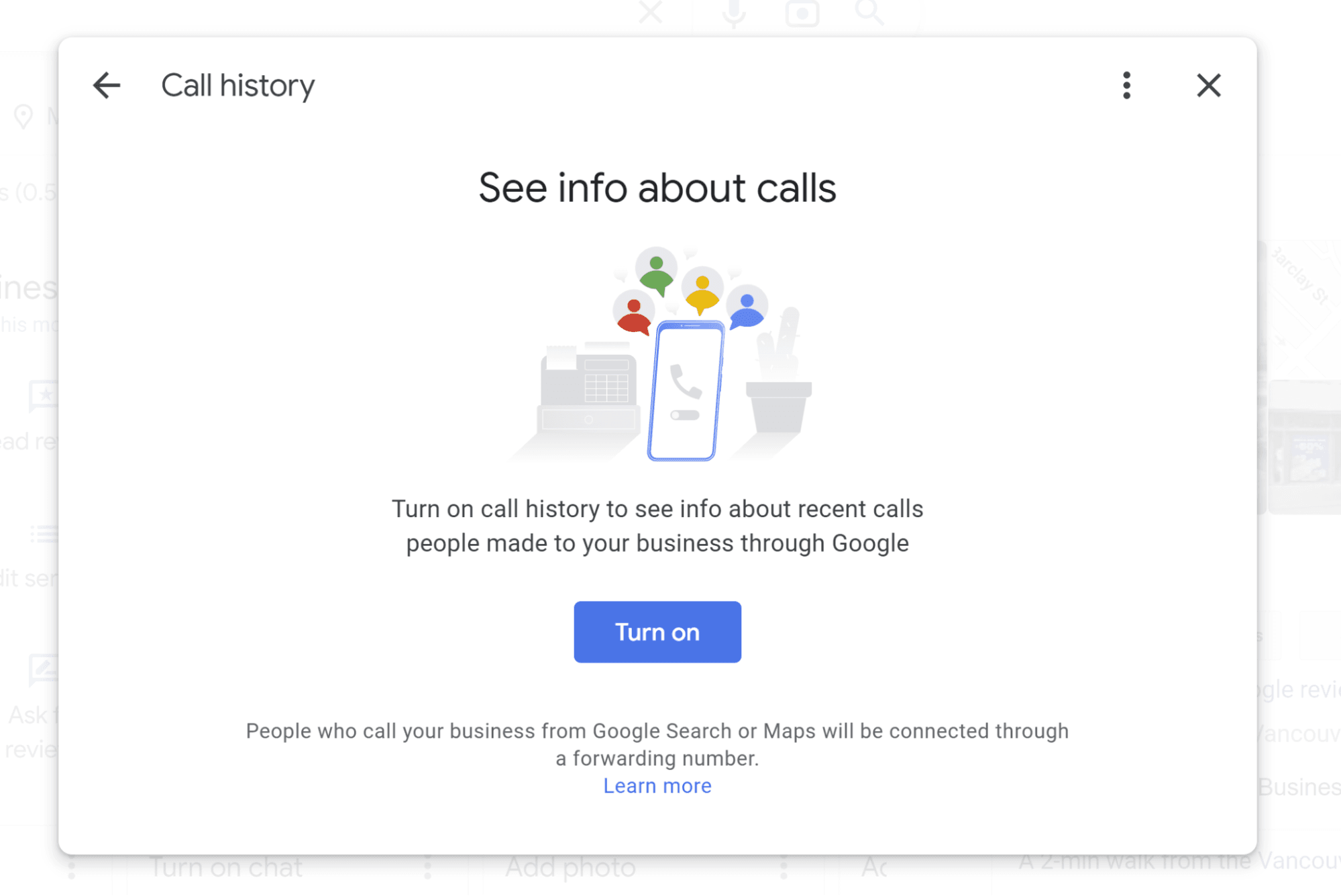
16. Further Location Information
In our example, Google is providing additional location information. Some listings will have a province or county listed in this area. Others will have a different special feature called “located in” that can appear when a business or department is contained within another entity, like the parts department inside an automotive dealership:

Controllable?
Partly — the information about your province or county relates to the physical address you provide, but the separate “located in” feature can only be edited via Google Maps. If you wish to edit this feature, find your listing on Google Maps, click the “suggest an edit” button, and look for the “located within” area of the editor:
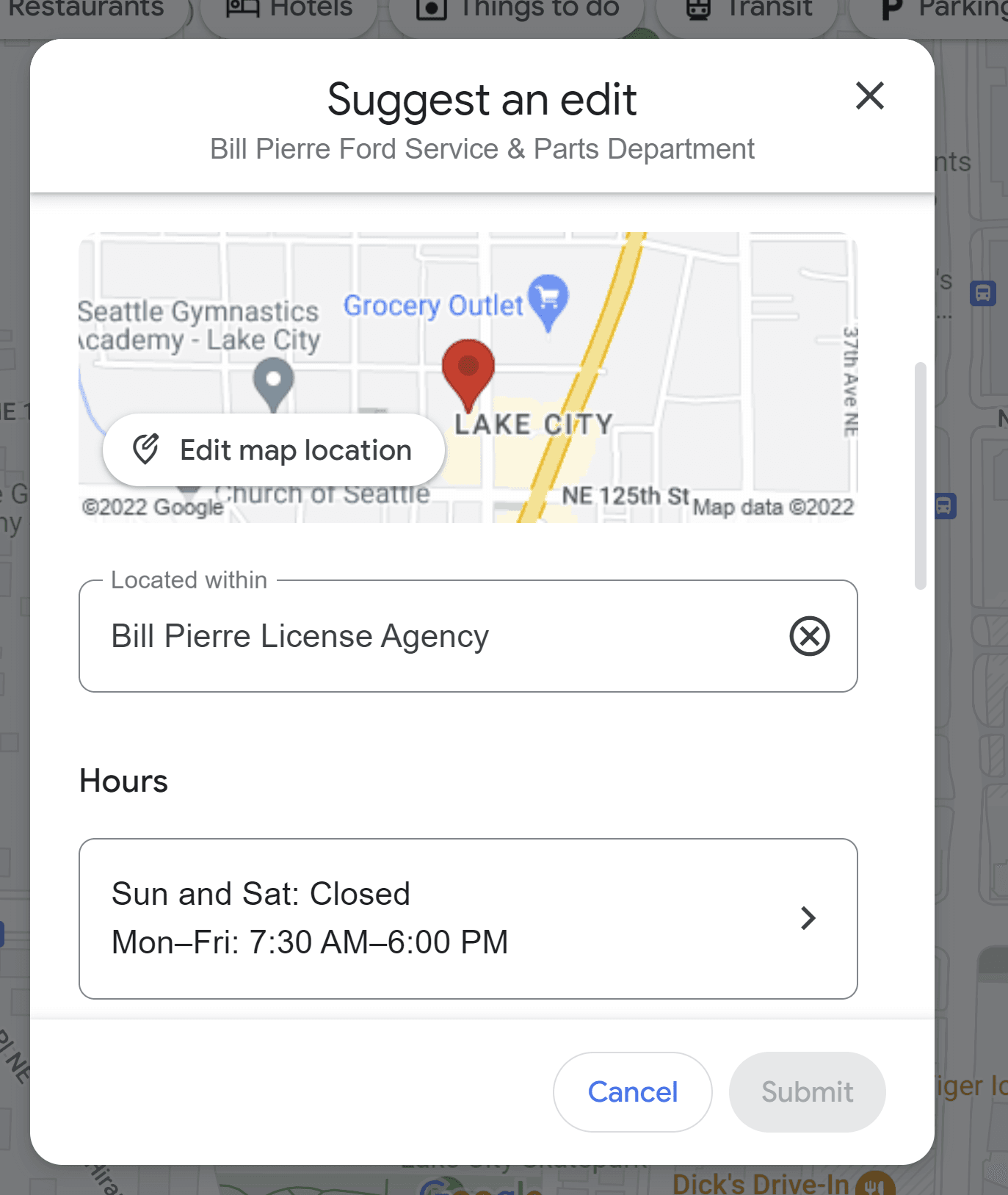
17. Suggest an edit
This function is available to any member of the public who wishes to suggest an edit to the listing. For example, an individual can let Google know they think your address, or hours of operation, or phone number is wrong.
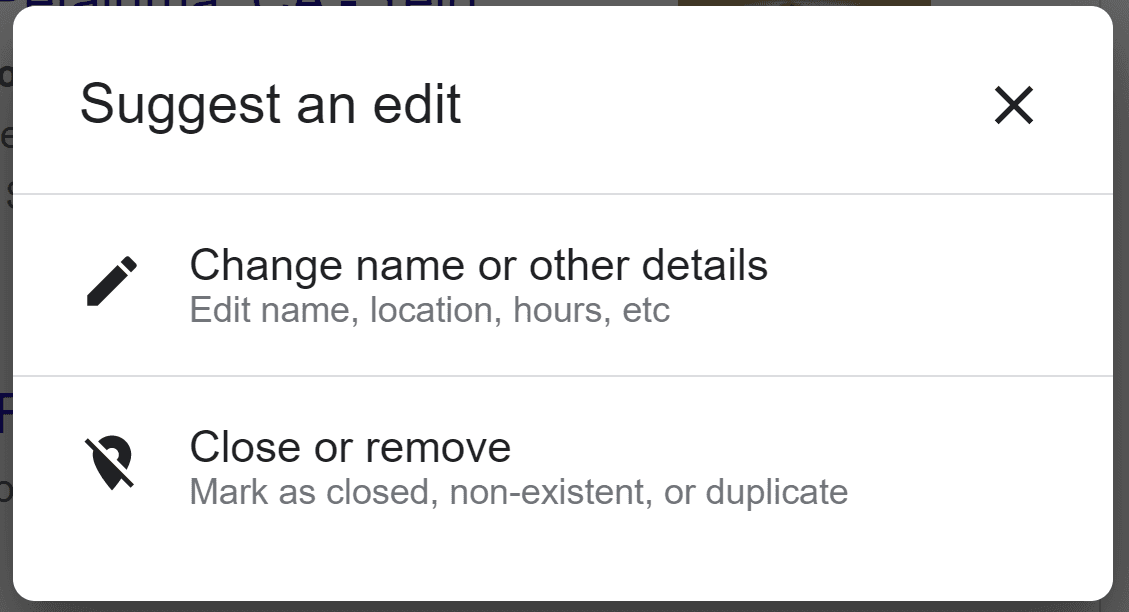
Controllable?
No. Unfortunately, the suggest an edit feature is a cause of confusion and stress for many local business owners who have no control over whether or not members of the public suggest edits to listings. The difficulty of the scenario is summed up well by this Diamond Product Expert in Google’s help forum:
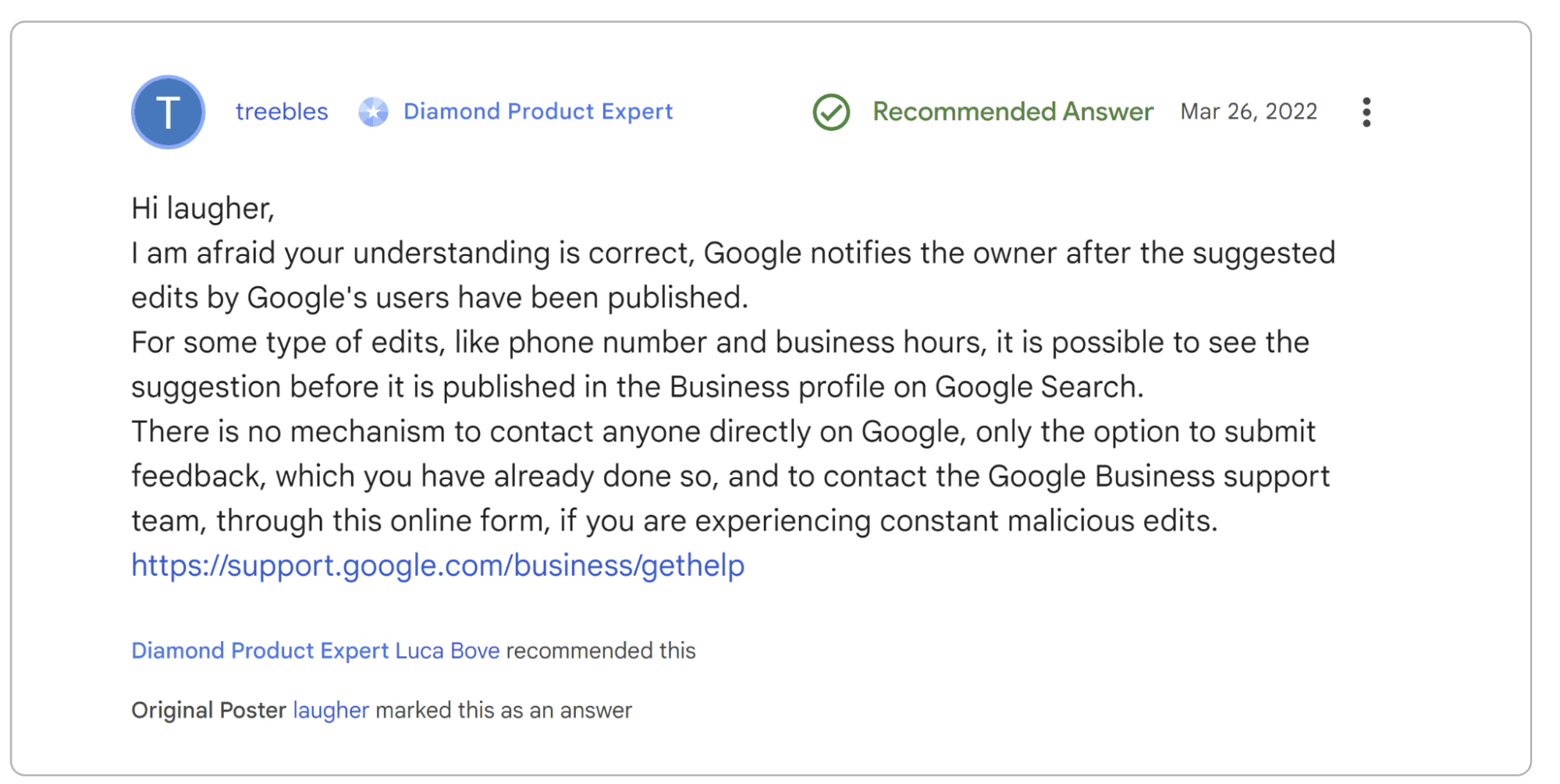
18. Own this business?
If you see this link on a listing, you either haven’t claimed the listing in question or are not logged into the account you used to claim the listing. Claiming a listing is the terminology for verifying with Google that you are authorized to take control of the management of a listing for a specific business. If, however, you are logged in properly and have already claimed the listing, you should see this link, instead:

Controllable?
Yes — you can claim listings you have the authority to represent and once you have claimed them, you can use the edit link to be taken to the NMX to edit your listing at any time.
19. Products
You can greatly enhance your listing by adding products to it representing key offerings in your inventory. These can be physical products, like retail goods, digital products, like software, or intangible products, like home services. You can add a price, description, buttons, and links for more information.
Controllable?
Yes — you can add products.
Where to control?
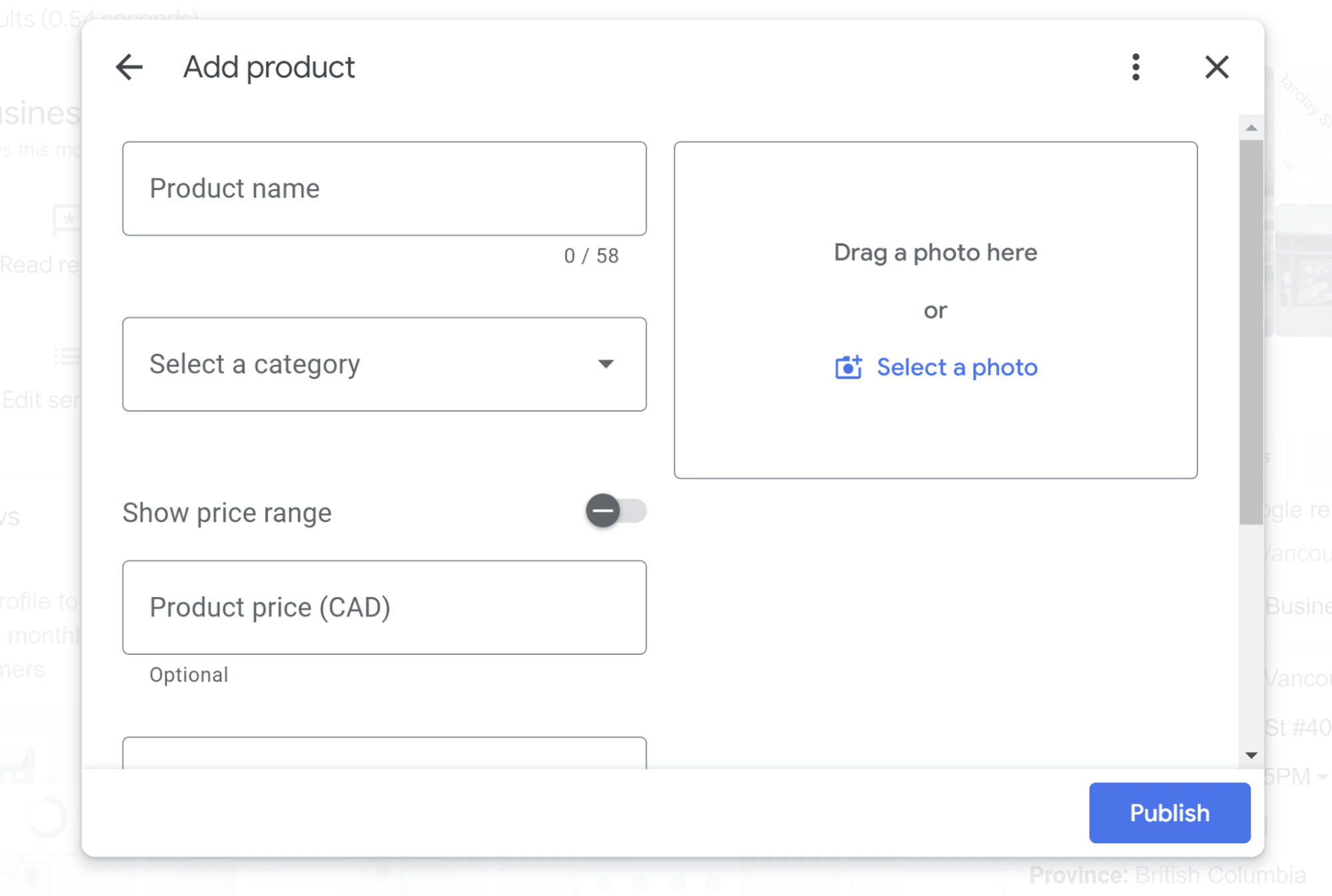
In the NMX, click “Edit Products” then click, “Add product” to be taken to the product editor.
20. Questions & Answers
Businesses are permitted to use this feature to upload questions they commonly receive and answer them. The public can also ask questions and answer the queries others have submitted. It’s important to continuously monitor this area of the GBP to be sure that questions from the public are receiving timely, authoritative answers from your brand, rather than random answers from the public which may or may not accurately reflect the business.
Controllable?
Partly — you can ask and answer questions but the public can also both ask and answer.
Where to control?

To add and answer questions, click the “Q&A” link in the NMX and you’ll be taken to this interface where you can either ask or answer questions.
21. Reviews
Reviews and owner responses are some of the key features that turn a static local business listing into an interactive two-way medium. For deep insight into the best strategies for review management, read The Impact of Local Business Reviews on Consumer Behavior | SEO Industry Report, but in brief, reviews are the main online seat of local business reputation, they influence local search rankings, and ratings, review text, and owner responses all have significant impacts on customer journeys. To avoid reputation damage and litigation, all review management practices must align with platform guidelines, like Google’s content guidelines, as well as the laws, like FTC guidelines, governing your country.
Controllable?
Partly — you can request reviews and respond to reviews, but you cannot control whether customers leave you reviews and you are not permitted to review your own business or incentives others to do so. Fraudulent reviews can be reported to Google in hopes of removal.
Where to control?
The NMX has several different menu items related to reviews, including “read reviews” and “ask for reviews”. Clicking on the former will take you to the entire review overlay, with “reply” functionality so that you can respond to each review or rating you receive:

Clicking on the latter will take you to a popup that generates a handy link to your review profile, with prompts to share that link via vehicles like email, WhatsApp or Facebook:
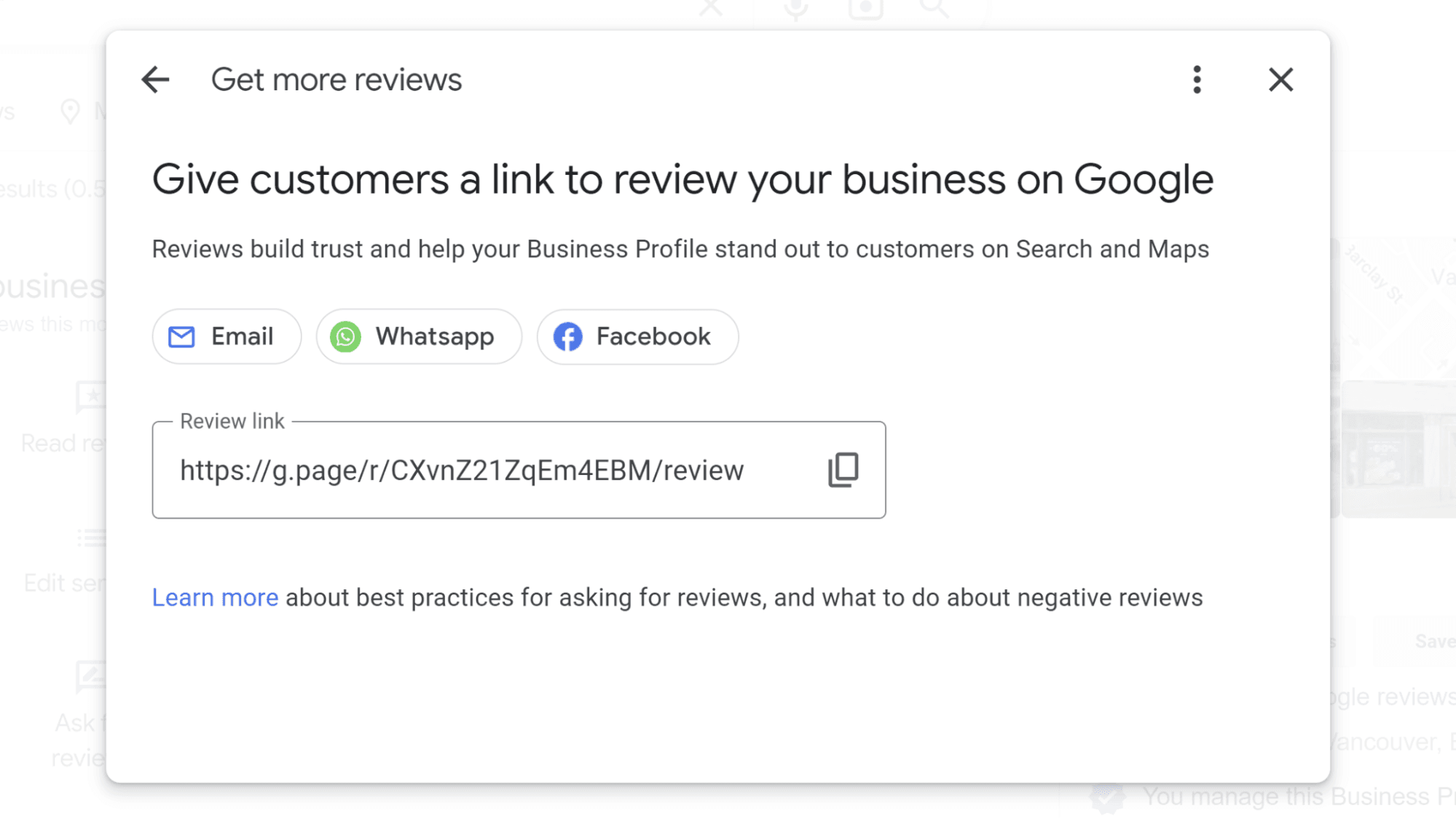
22. Updates (formerly known as Google Posts)
This feature is like a microblogging function located directly within your Google Business profile. It enables you to post new content to your listing on a regular business.
Controllable?
Yes, most business types (with some exceptions) can write updates.
Where to control?
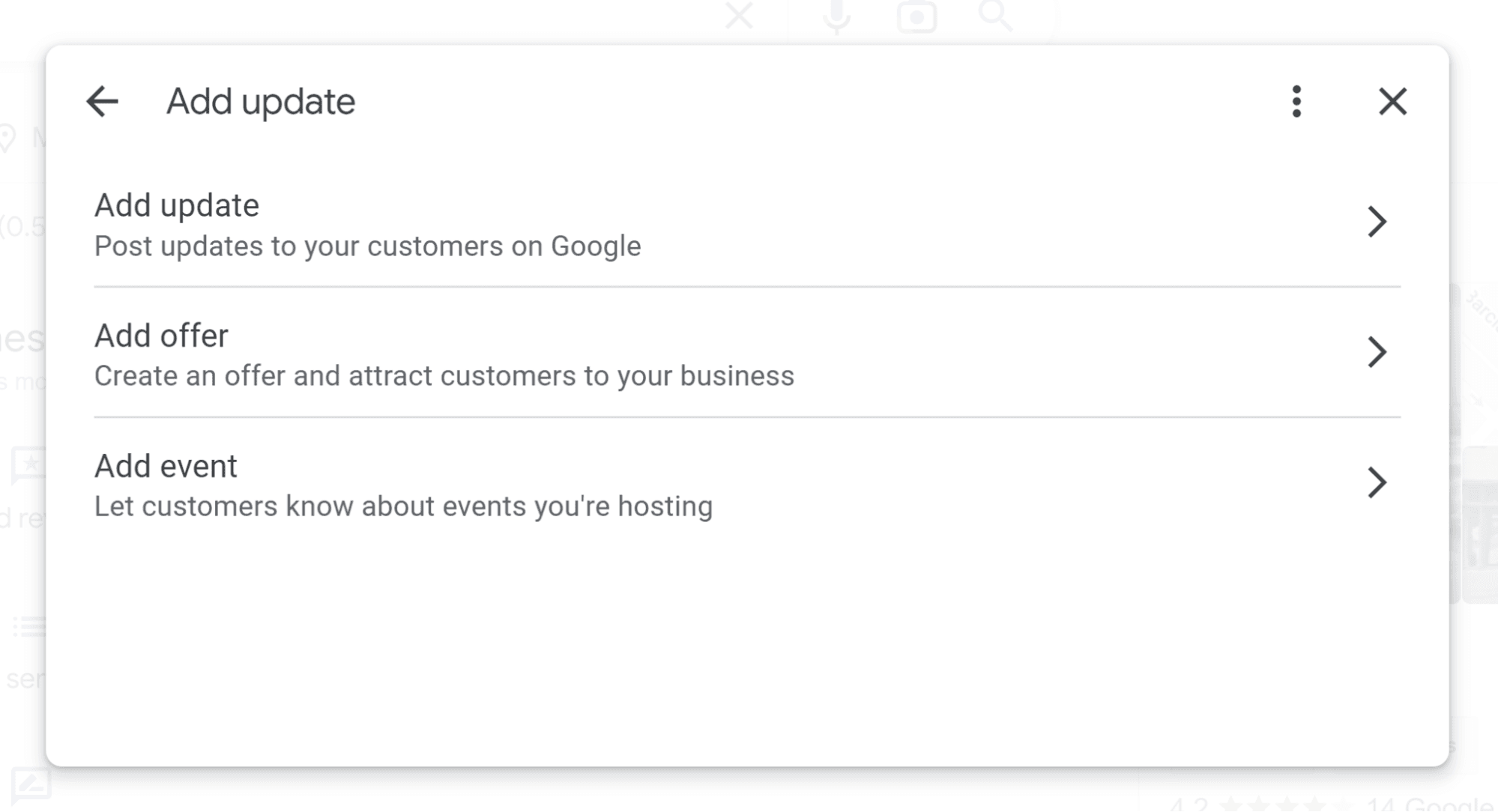
Click the “add update” link in the NMX and you’ll be shown three types of posts you can write: updates, offers, and events. The first lets you add an image, a description, and a linked button and will stay live for six months before being archived. The second includes all these fields, plus a date range setting for the period in which your offer is live, and additional informational fields to further explain the terms of your offer. The third type includes fields for information like when your event starts and ends. Some listings may also feature discontinued post types.
23. People Also Search For
This is one of those areas that makes it clear that local business rent space from Google rather than owning it. Chances are, if you owned your Google Business Profile, you wouldn’t feature your competitors on it, but this is just what Google does.
Controllable?
No — you have no control over which competitors Google shows in this section of your listing.
Additional GBP and NMX Features
Some business categories have unique Google Business Profile features or elements we haven’t yet covered. The New Merchant Experience also includes some other functions we’ve yet to explore. Let’s dive back in!
Categories
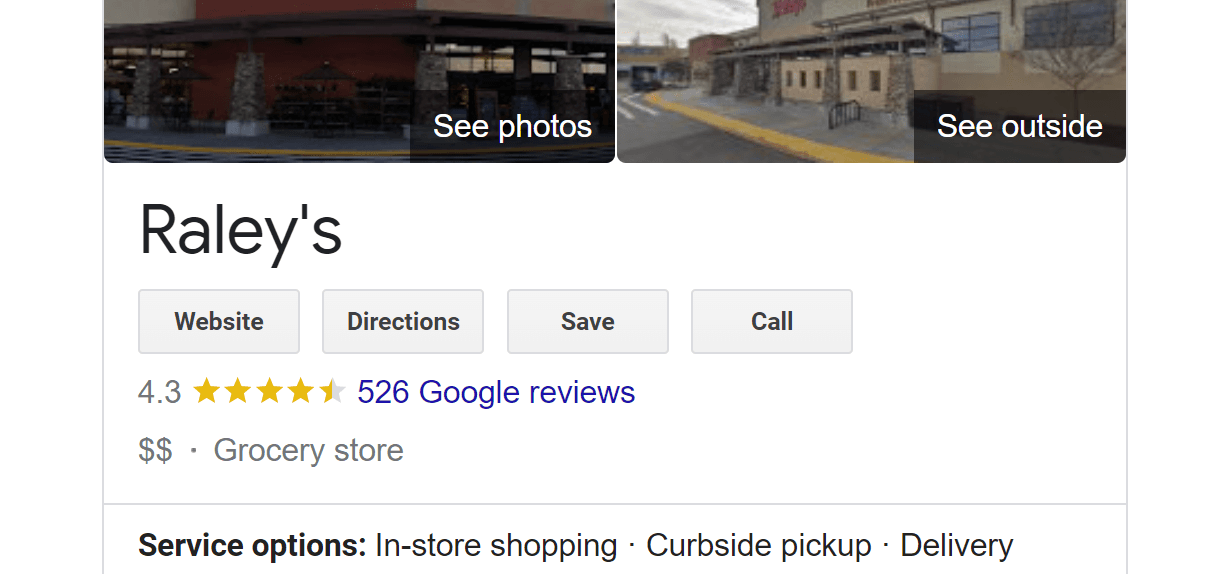
Categories may be the most important feature that you control when it comes to the search phrases you want to rank for, and categories also determine many of the fields you’ll have in your Google Business profile. Your primary category may appear on its own near the top of your GBP, but it also may appear as part of your editorial summary. In order to see all of your categories live, you have to head over to Google Maps. There, by using a Chrome extension like GMBSpy, you can see all the categories both you and your competitors are using.
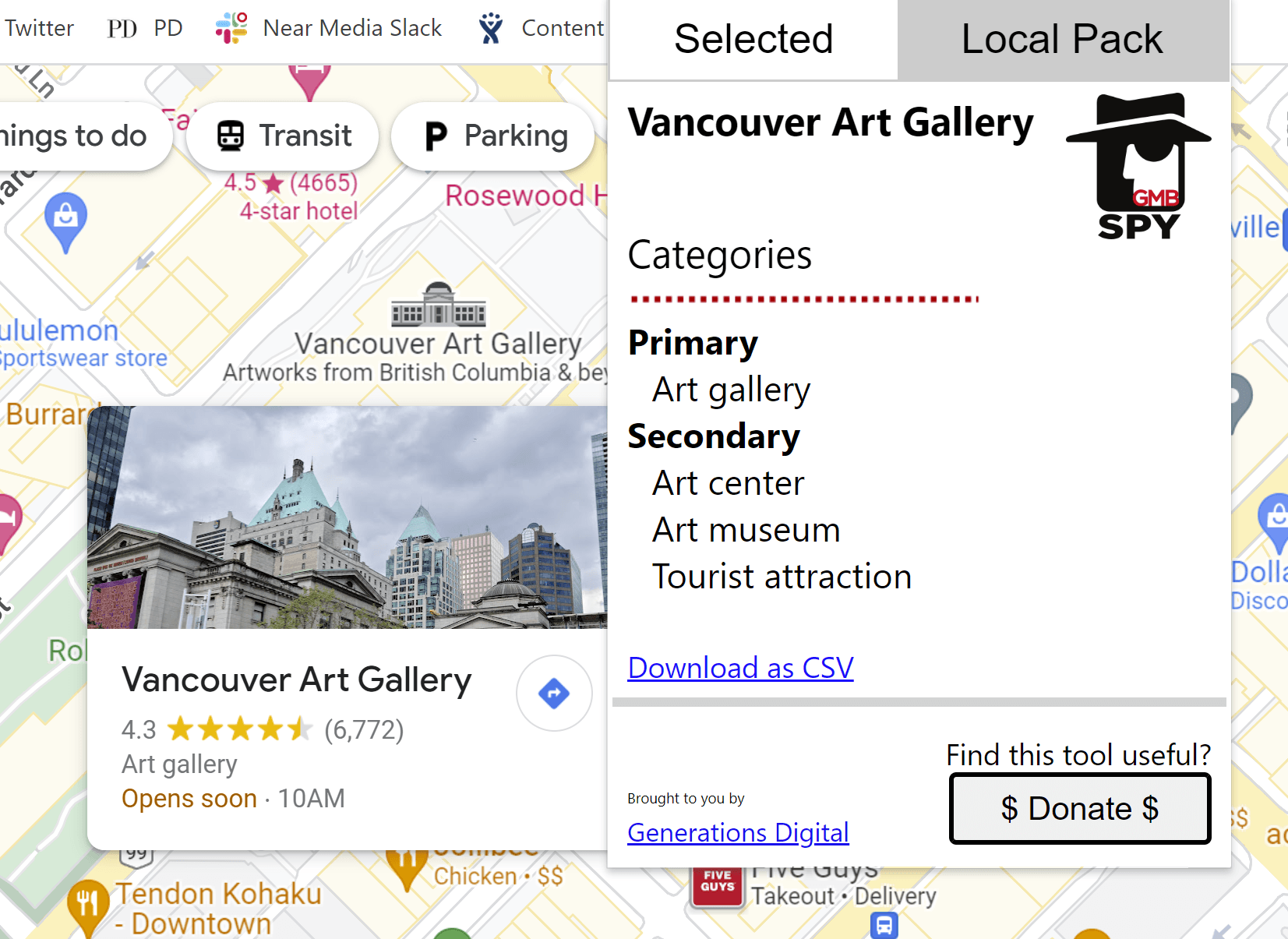
Controllable? Yes — businesses can choose primary and secondary categories.
Where to control? Click on “Edit Profile” in the NMX and edit your categories under the “About” tab.
Attributes
This is an experimental area of GBPs to which Google is always adding so that both businesses and the public can further define the characteristics of the business. Attributes can include information about who owns the business, or amenities, such as whether a building has gender-neutral restrooms, or protocols, such as whether an appointment is required to visit a business, or layout information, such as the presence of wheelchair-accessible entrances.
Controllable? Partly — businesses can add a great many attributes by clicking the “Business Information” tab in the NMX and then going to the “More” section. However, Google also crowdsources attributes from the public.
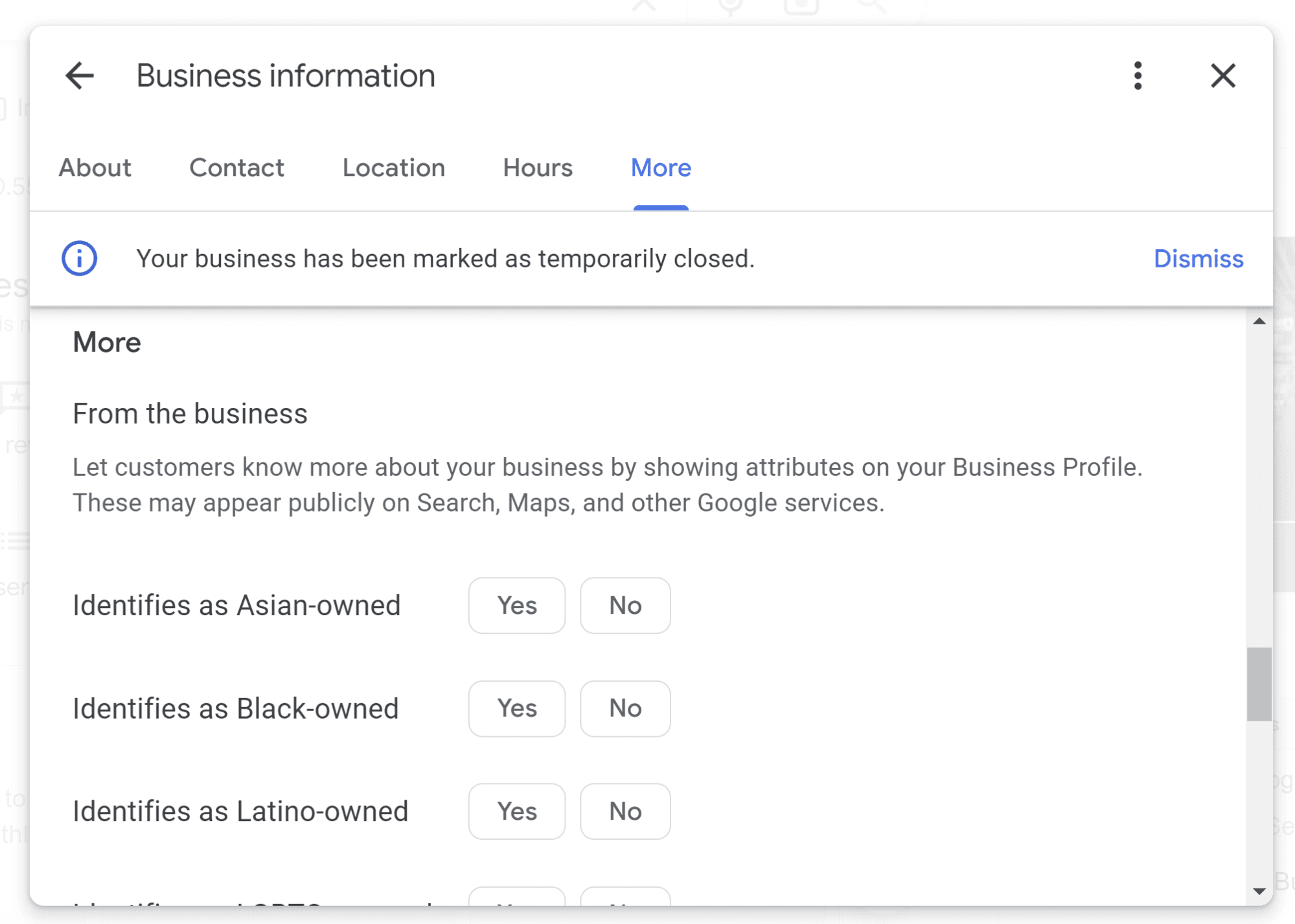
Description
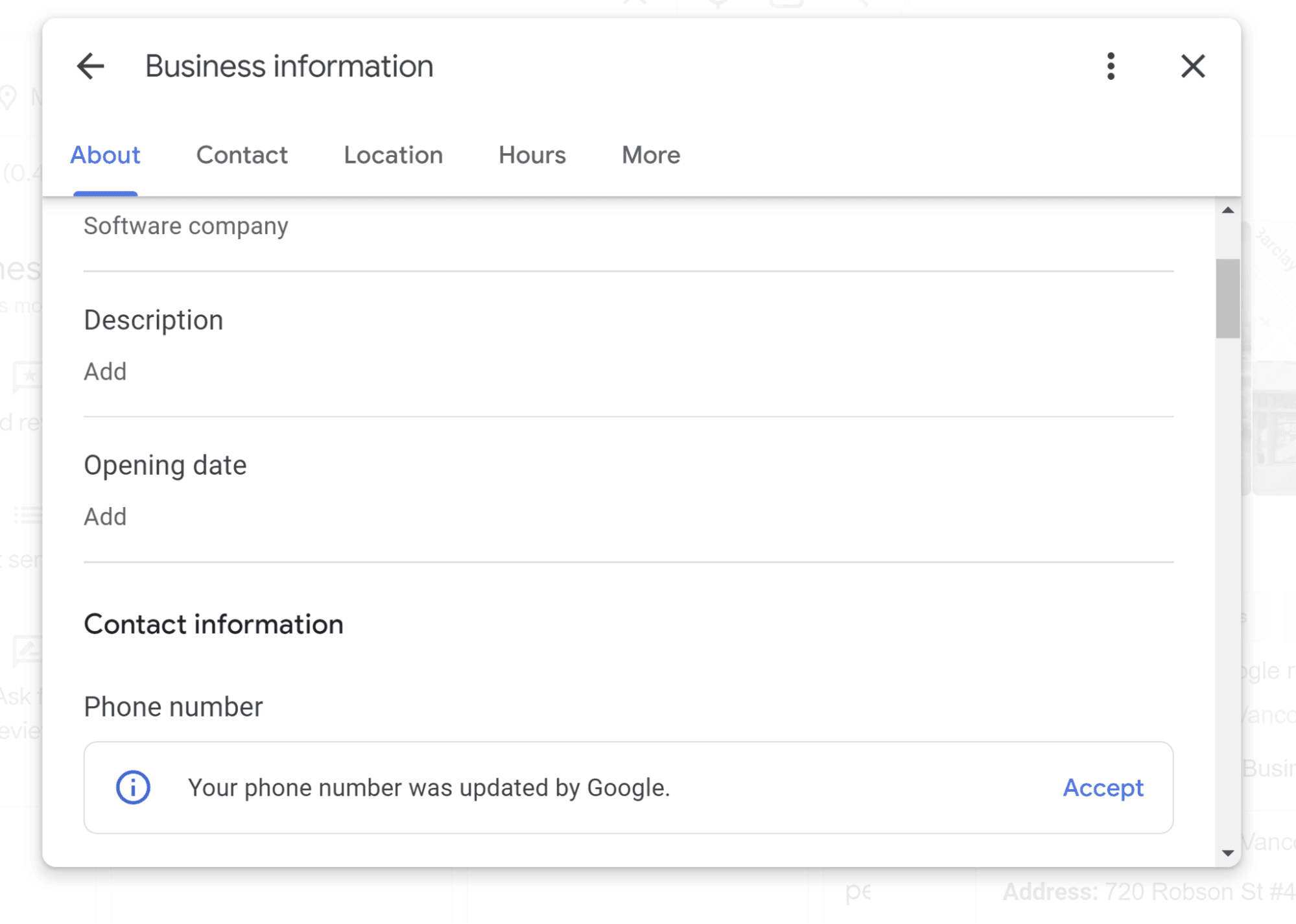
Local businesses can write a 750 character description of themselves.
Price Summary

Some business listings display a pricing overview of 1-4 dollar signs.
Controllable?
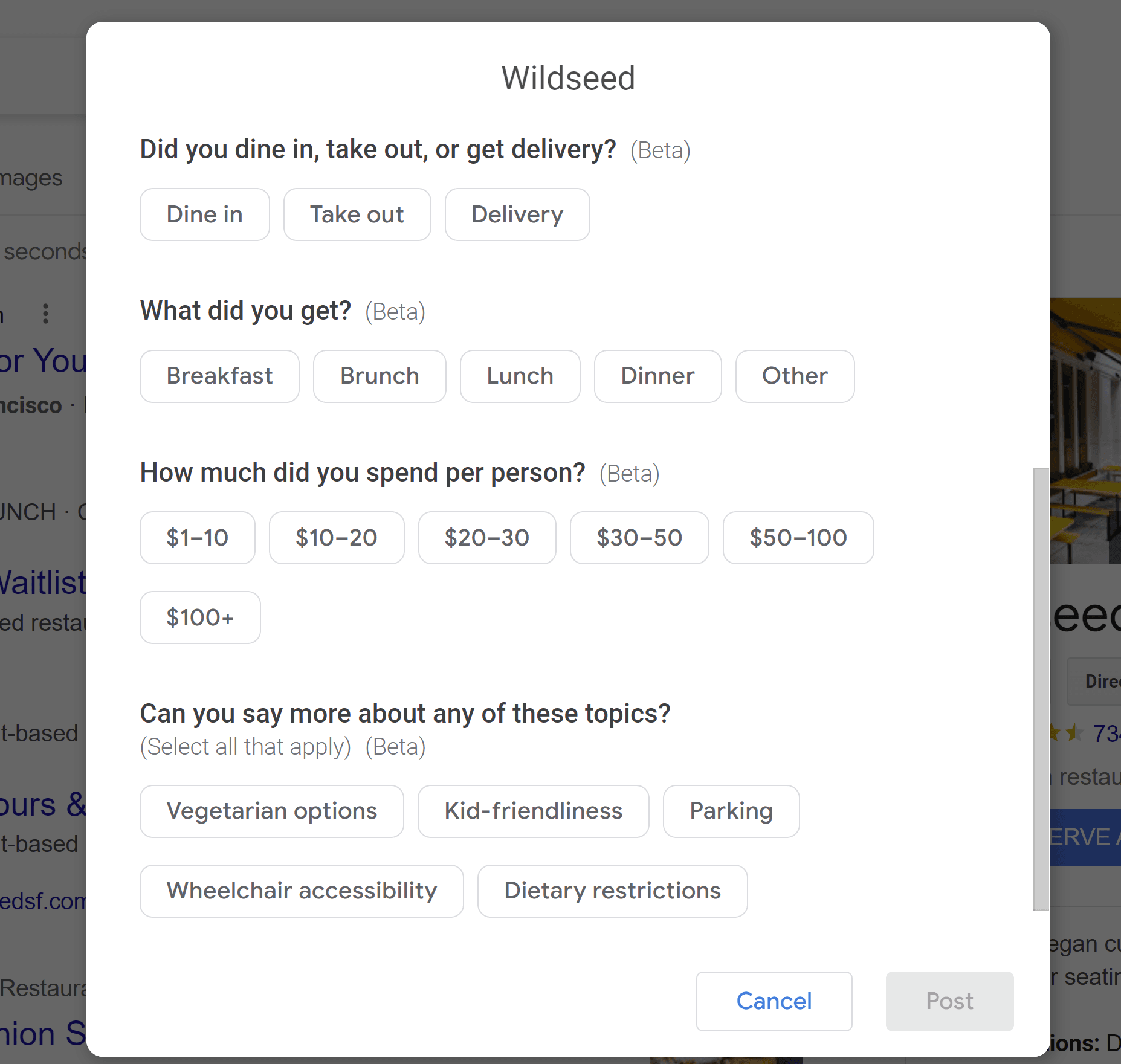
Controllable?
Unknown – Google asks reviewers to evaluate the prices they’ve paid at businesses, as seen above. There has been past debate over whether the prices published by local businesses on their digital menus influence these attributes, but Diamond Product Expert Ben Fisher has confirmed with Google that these elements stem entirely from UGC.
Menu links

Google offers a variety of menu options for businesses. Food and drink businesses have a standard menu that can link to a page on their website or a third-party platform, and menus can be created within Google itself, including menus with photos added to them. Additionally, some businesses can create service menus in Google.
Controllable?
Yes — where relevant, businesses can create or link to menus of goods and services.
Where to control?

With thanks to Damian Rollison, logged in owners of food and drink establishments should see edit menu links in the NMX, as shown above.
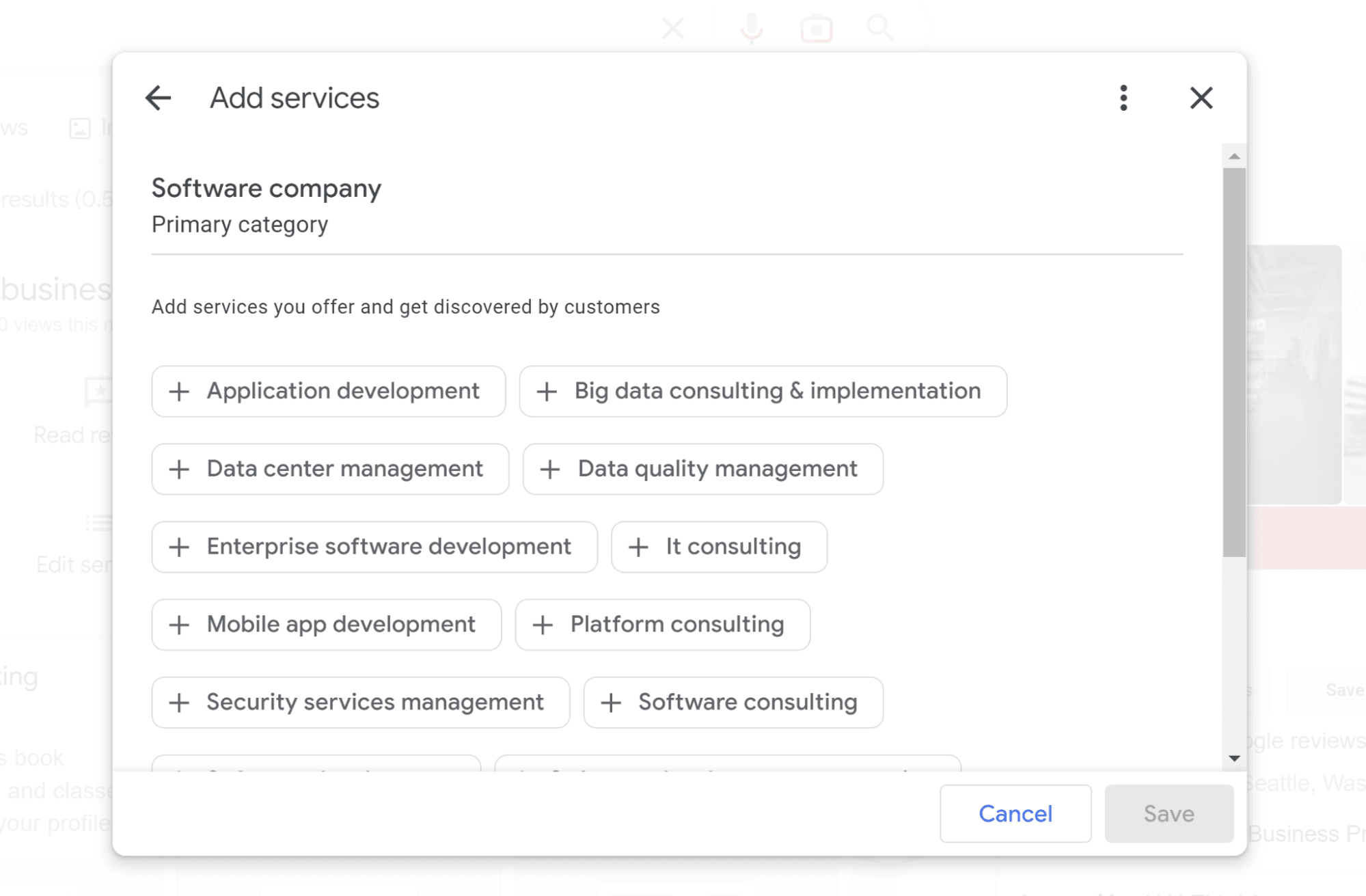
Businesses offering a menu of services can edit them under the “Edit Services” link in the NMX, including adding custom services.
Booking
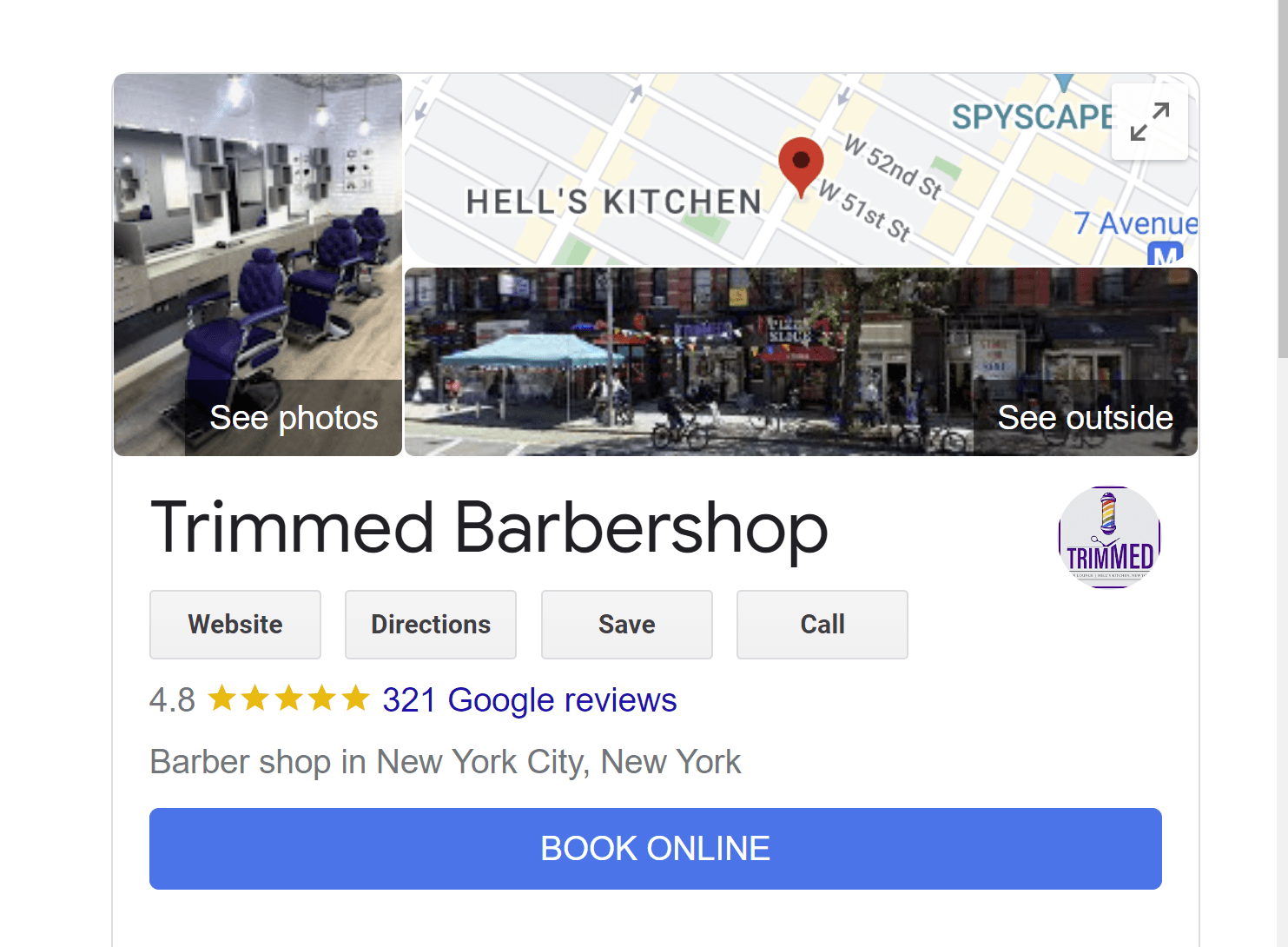
Businesses can feature several different booking and appointment functions on their listings, powered by a provider. For example, this instance on the listing of a dental practice stems from ZocDoc:
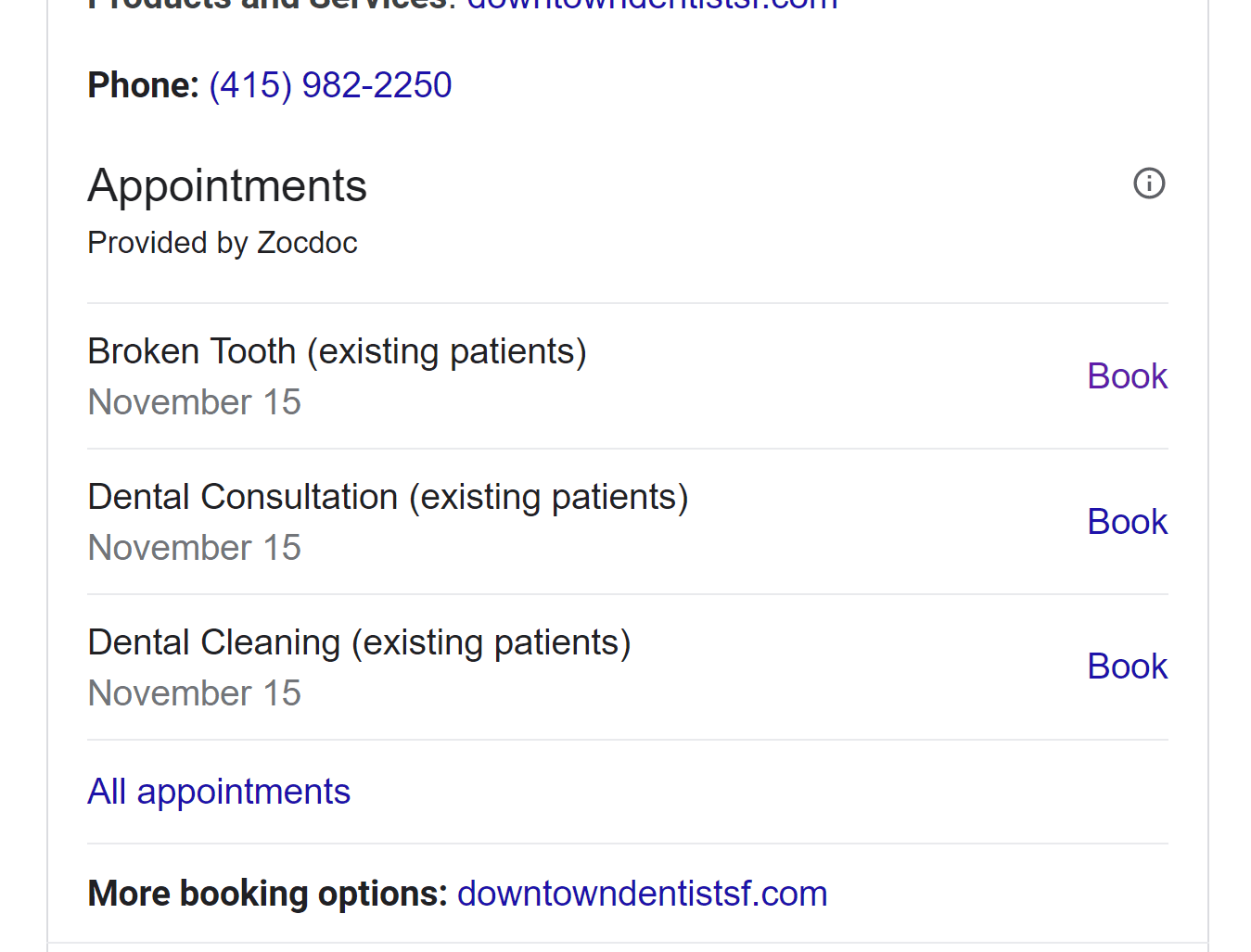
Controllable? Yes, relevant businesses can add booking and appointment features.
Where to control?
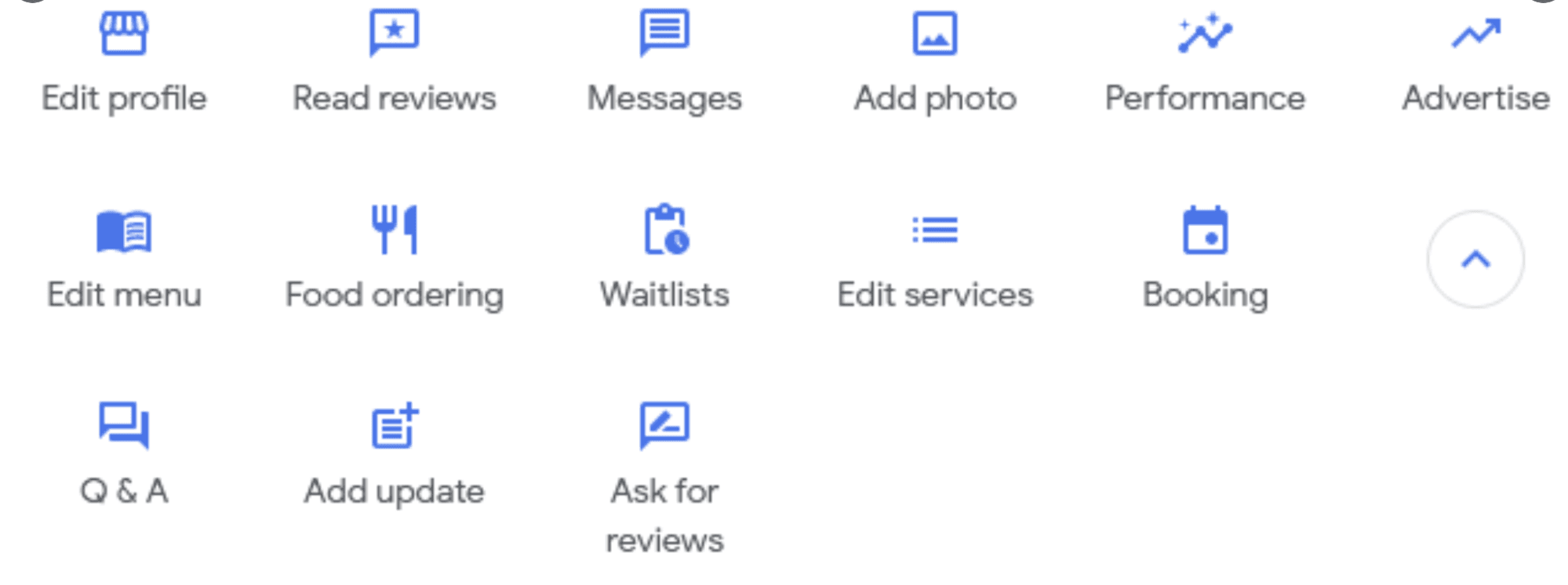
With thanks to Petra Kraft for the screenshot, applicable businesses should see a booking button in the NMX, as shown above. Businesses wishing to enable booking and appointment features must follow these instructions and can learn more about the Reserve With Google system here. Also pictured here is the “Waitlists” function tied to the Reserve with Google program for managing queues of potential diners.
See what’s in store

The See What’s In Store feature shows up on the Google Business Profiles of companies that have integrated the Pointy device into their point of sales system.
Controllable? Yes, if you are in the US, UK, CA, IE, or AU, have an appropriate point of sales system, and vend items with standard barcodes, you can apply to become part of this program.
Where to control? Google’s documentation states that, depending on how you signed up to be part of their See What’s in Store program, you will either be managing your inventory directly via Pointy or within your Google Business Profile.
Order online
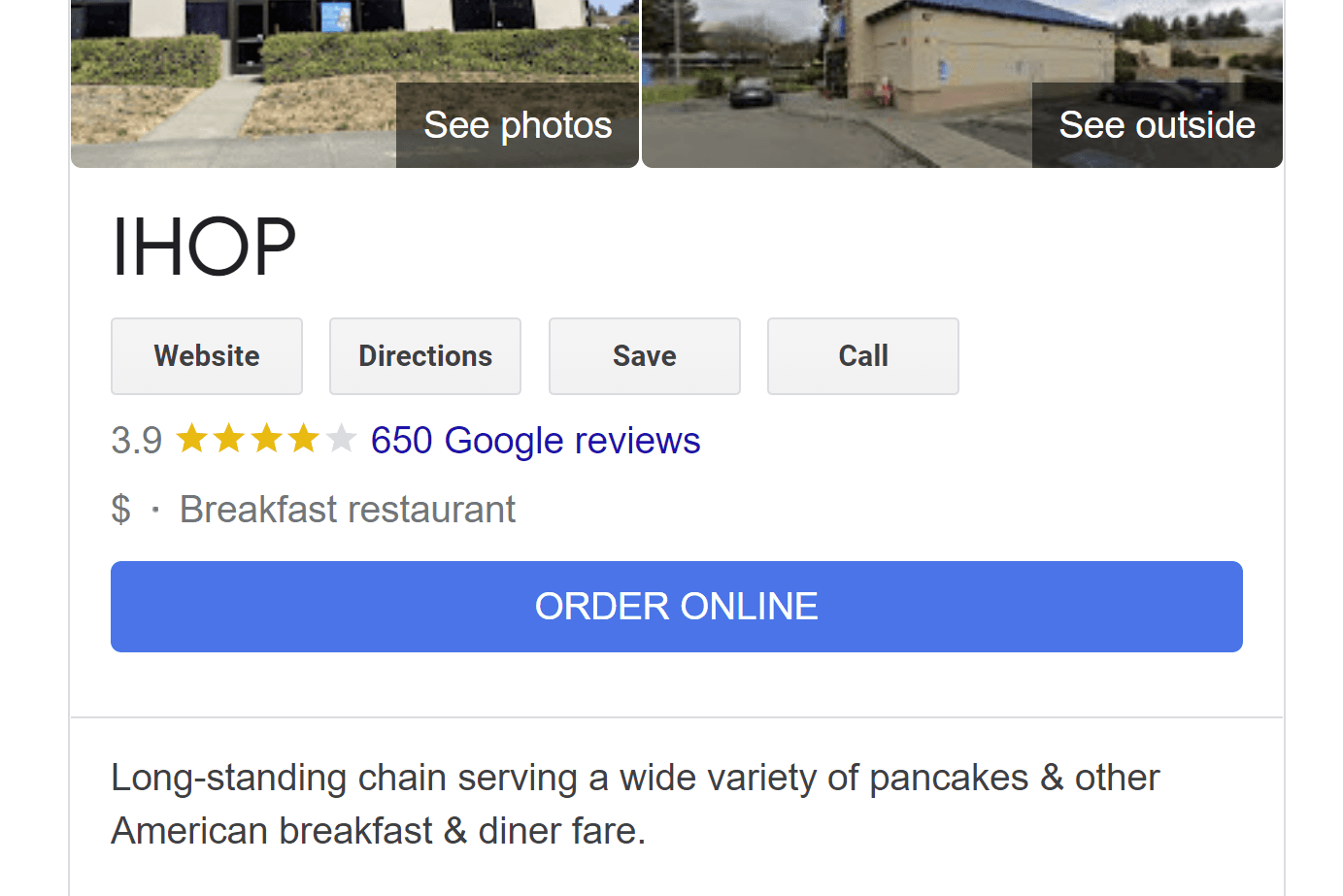
Some GBPs may feature an order online button . When clicked on, it brings up a list comprised of the brand as well as third-party services that facilitate taking digital payments in exchange for goods that can then be picked up or delivered.

Controllable? Partly — business owners can opt into this, but there has been considerable controversy over the years about whether third-party providers in the delivery business are more of a bane or blessing to local brands, and whether or not its right for Google to promote these types of services on GBPs.
Reviews from the web

This features a rating summary and links to relevant third-party review sources, determined by Google.
Controllable?
Partly — owners can’t dictate which 3rd parties Google chooses, but they can work to build up positive reviews on featured sources.
Profiles

Google business profiles can feature icon-based links to major social media sites where the company has established a presence.
Controllable? No — there is no field in the NMX for adding your social media profiles, but best practice advice is to be sure they are featured on your website so that Google can easily associate them with the business.
Popular times
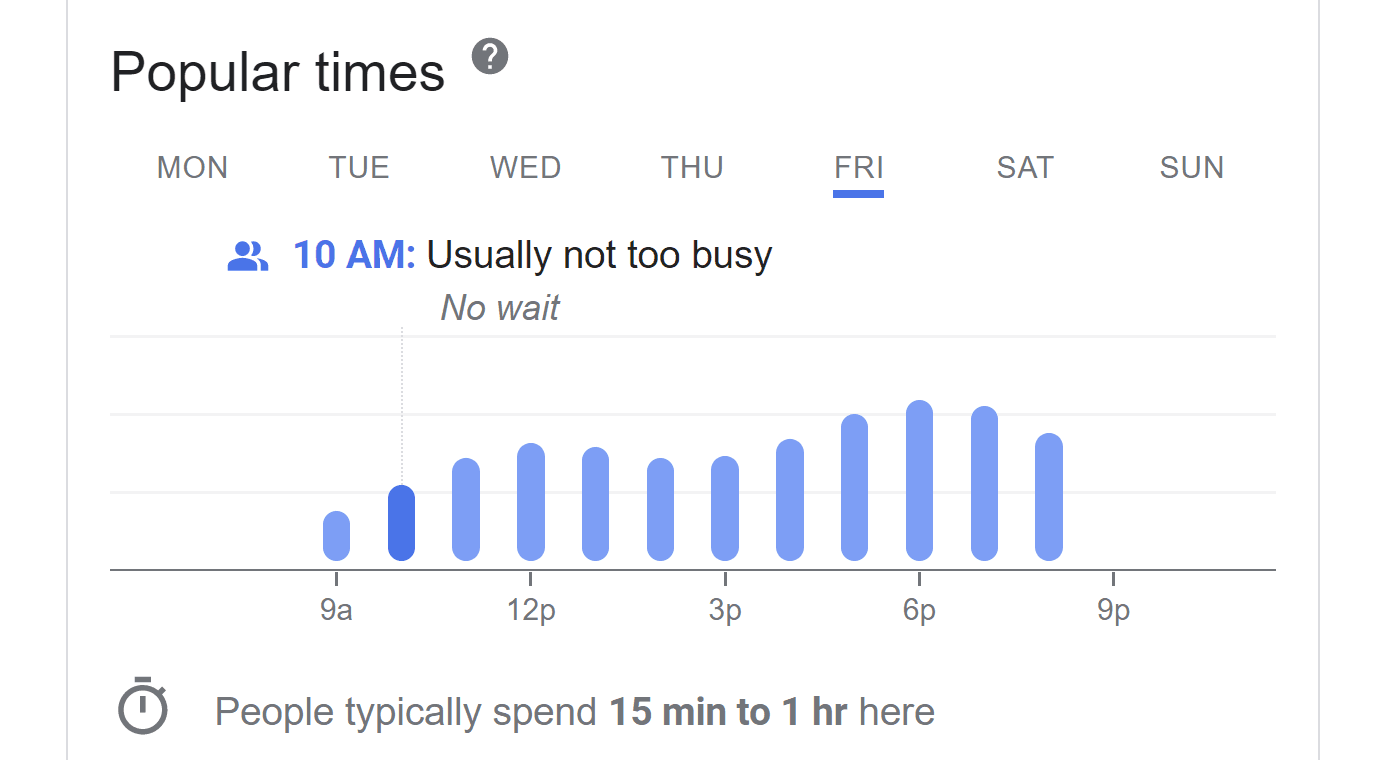
This Google Business Profile information is drawn from users who have opted into Google Location History. It’s meant to help users plan visits. It’s conceivable that this could be utilized as a ranking factor.
Controllable?
No.
Chat/Messaging
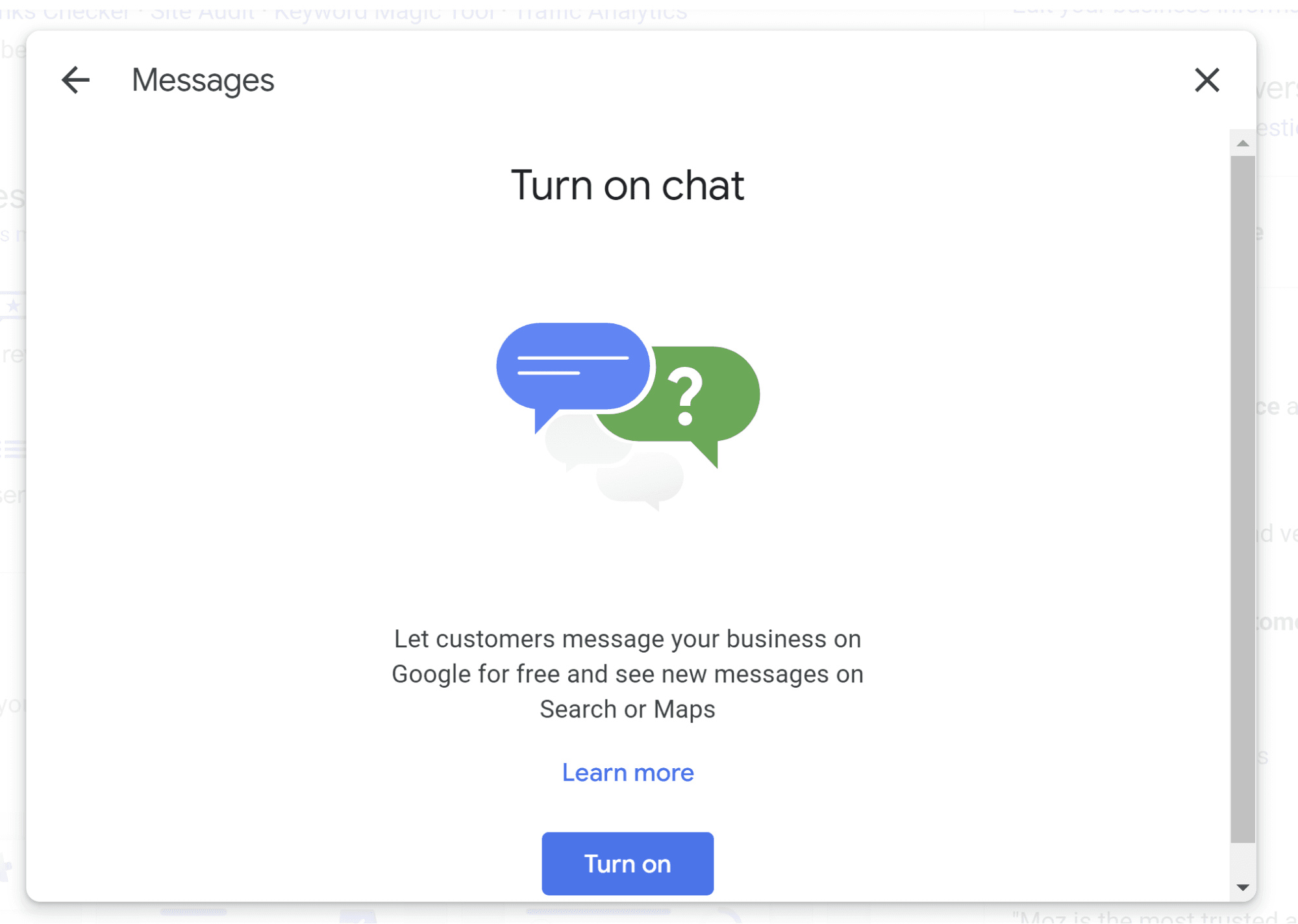
This feature enables customers to leave messages for businesses and receive responses.
Controllable? Yes — businesses can choose to opt into this.
Where to control? Google’s branding of this feature is messy. In the NMX it is labeled Messages, but when opting into the program, you will be shown a popup asking if you want to turn on “chat”, and customers will see buttons labeled “chat”. You can read more about this feature here.
Performance

The performance tab in the NMX takes you to the analytics data historically known as Insights. This is where Google reports on how the public is interacting with your listing.
Controllable? No — apart from changing the date ranges in this interface, this is not data you can edit.
Advertise

This link in the NMX takes you to where you can sign up to run paid advertising.
Controllable: Yes — local businesses can opt into Google Ads.
Admission

Some attractions feature admissions information on the Google Business Profile, with price comparisons for tickets.
Controllable? Not directly, though attractions can be sure pricing information is clear on their websites. This is a controversial feature, because Google states the following:
“Tickets are ranked based on several factors, but mainly by price. Official tickets are given preference in the ranking. Ticket suppliers don’t pay Google to appear in these search results and can’t pay to influence their ranking. Prices are based on standard adult entry and may vary depending on the specific ticket types, dates or eligibility for other discounts. Displayed currencies may differ from the currencies used to purchase tickets.”
However, as can be seen in my above example of the GBP of the Japanese Tea Garden in San Francisco, the official website of the attraction is being outranked in the Admissions results by an entity that is not official and is also more expensive, contrary to Google’s statement of how this feature should work.
Experiences
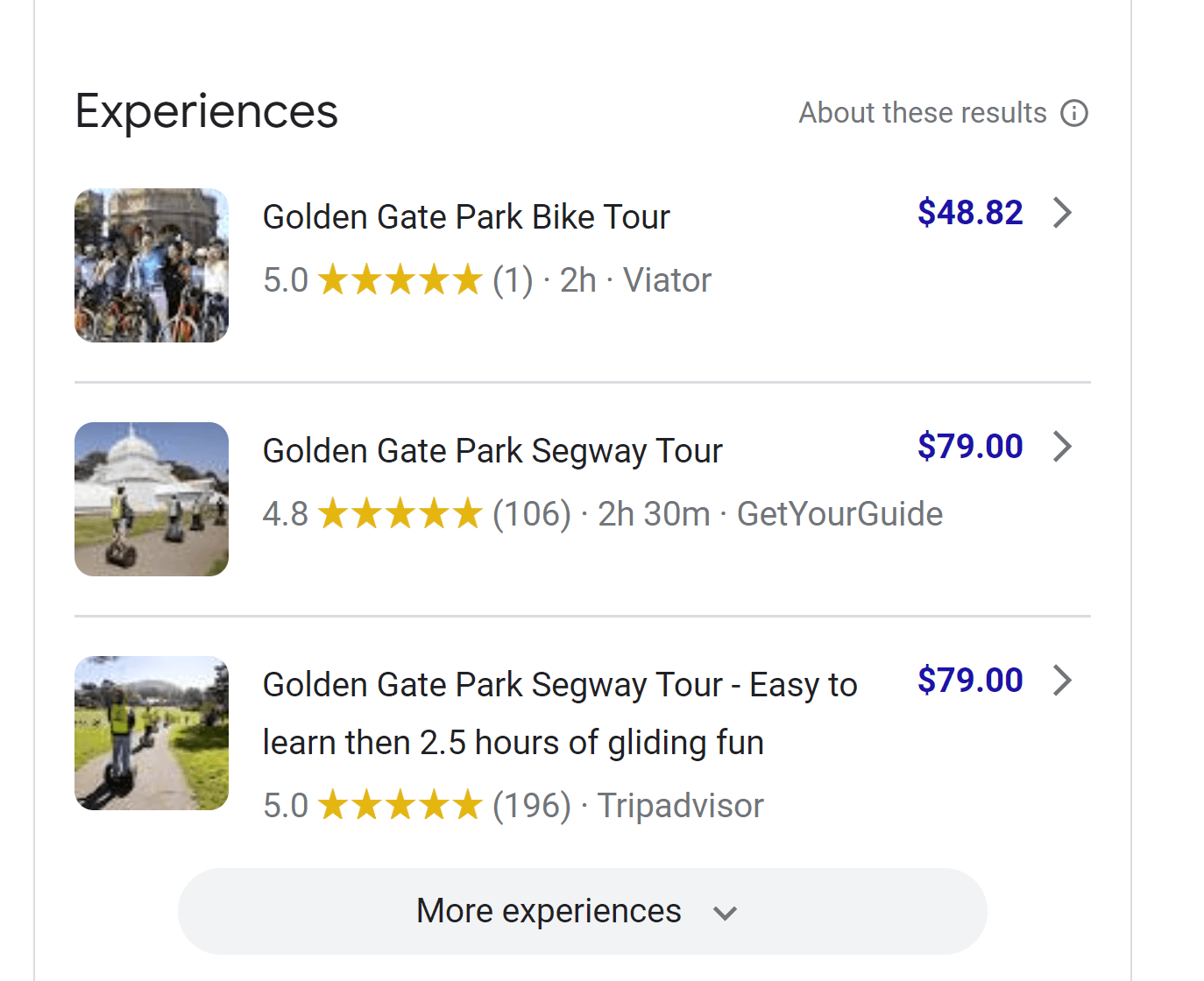
Some Google Business Profiles may included nearby experiences. This screenshot is also from the GBP of the Japanese Tea Garden in San Francisco, and is displaying other things to do in Golden Gate Park.
Controllable? No — this information is provided by Google, not the business owner.
Opening date
It has been some time since I have seen an opening date featured on a GBP, though I frequently spot them in local pack results, but businesses do have the ability to tell Google the month and year in which they were founded.
Controllable? Yes — businesses can provide this information.
Where to control?
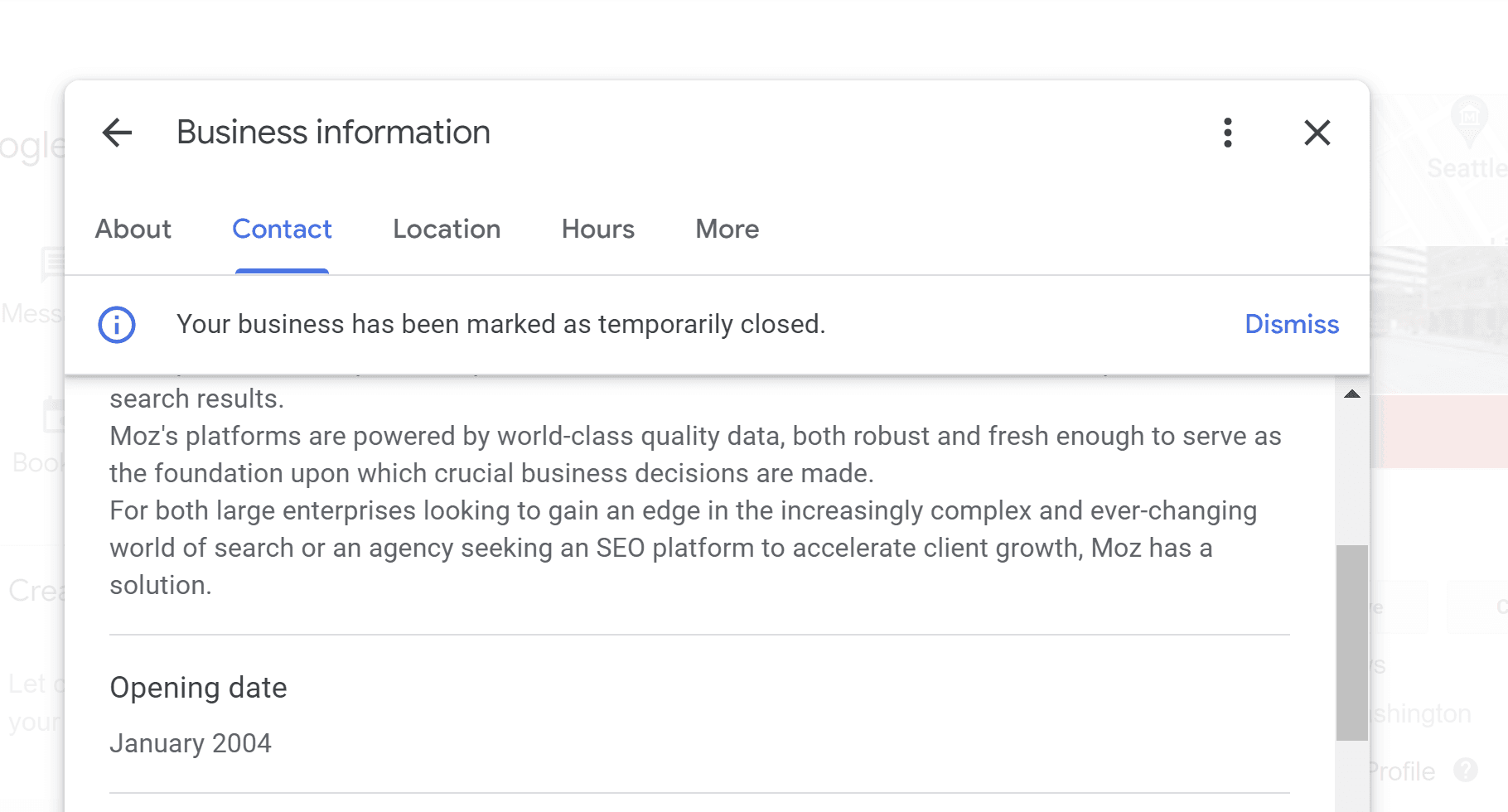
In the NMX, click on “Edit Profile” and then click on “Contact” to find the field for adding your founding date.
Lodging listings

Hotel profiles are unique to the point of being almost a different style of Google listing. They feature many distinct elements including price comparison, environmental practices, availability-based booking, and other features.
Controllable?
Mostly — owners have a variety of features they can enable and manage, though Google pulls in many elements from third parties including the public.
Where to Control? Hospitality marketers should familiarize themselves with these guidelines from Google.
Summing it up
Hopefully, this guide will act as a trusty flotation device the next time you need to manage something in your Google Business Profile via the New Merchant Experience. What I’ve learned from writing it is that if you click around long enough in the NMX, you can find most things, with a few exceptions like those that have been noted by friends like Damian Rollison and the good folks over at BrightLocal and Online Ownership.
This column has covered what the main features are and where to control them, but if you’re ready to move on to making the most of each element, read the popular Beginner’s Guide to Google Business Profiles for optimization and marketing tips. If you want to understand where GBPs fit within the larger framework of local search marketing, read The Essential Local SEO Strategy Guide for nine chapters of free, expert advice. Or, if you feel you’d benefit from investing in a more guided experience, consider registering for our video-based Local SEO Certification. Google will just keep changing – that’s a guarantee! Our best strategy, then, is to embrace continuing education. With determination and knowledge, we can all swim these laps for the win!
MARKETING
Ecommerce evolution: Blurring the lines between B2B and B2C

Understanding convergence
B2B and B2C ecommerce are two distinct models of online selling. B2B ecommerce is between businesses, such as wholesalers, distributors, and manufacturers. B2C ecommerce refers to transactions between businesses like retailers and consumer brands, directly to individual shoppers.
However, in recent years, the boundaries between these two models have started to fade. This is known as the convergence between B2B and B2C ecommerce and how they are becoming more similar and integrated.
Source: White Paper: The evolution of the B2B Consumer Buyer (ClientPoint, Jan 2024)
What’s driving this change?
Ever increasing customer expectations
Customers today expect the same level of convenience, speed, and personalization in their B2B transactions as they do in their B2C interactions. B2B buyers are increasingly influenced by their B2C experiences. They want research, compare, and purchase products online, seamlessly transitioning between devices and channels. They also prefer to research and purchase online, using multiple devices and channels.
Forrester, 68% of buyers prefer to research on their own, online . Customers today expect the same level of convenience, speed, and personalization in their B2B transactions as they do in their B2C interactions. B2B buyers are increasingly influenced by their B2C experiences. They want research, compare, and purchase products online, seamlessly transitioning between devices and channels. They also prefer to research and purchase online, using multiple devices and channels
Technology and omnichannel strategies
Technology enables B2B and B2C ecommerce platforms to offer more features and functionalities, such as mobile optimization, chatbots, AI, and augmented reality. Omnichannel strategies allow B2B and B2C ecommerce businesses to provide a seamless and consistent customer experience across different touchpoints, such as websites, social media, email, and physical stores.
However, with every great leap forward comes its own set of challenges. The convergence of B2B and B2C markets means increased competition. Businesses now not only have to compete with their traditional rivals, but also with new entrants and disruptors from different sectors. For example, Amazon Business, a B2B ecommerce platform, has become a major threat to many B2B ecommerce businesses, as it offers a wide range of products, low prices, and fast delivery
“Amazon Business has proven that B2B ecommerce can leverage popular B2C-like functionality” argues Joe Albrecht, CEO / Managing Partner, Xngage. . With features like Subscribe-and-Save (auto-replenishment), one-click buying, and curated assortments by job role or work location, they make it easy for B2B buyers to go to their website and never leave. Plus, with exceptional customer service and promotional incentives like Amazon Business Prime Days, they have created a reinforcing loyalty loop.
And yet, according to Barron’s, Amazon Business is only expected to capture 1.5% of the $5.7 Trillion addressable business market by 2025. If other B2B companies can truly become digital-first organizations, they can compete and win in this fragmented space, too.”
If other B2B companies can truly become digital-first organizations, they can also compete and win in this fragmented space
Joe AlbrechtCEO/Managing Partner, XNGAGE
Increasing complexity
Another challenge is the increased complexity and cost of managing a converging ecommerce business. Businesses have to deal with different customer segments, requirements, and expectations, which may require different strategies, processes, and systems. For instance, B2B ecommerce businesses may have to handle more complex transactions, such as bulk orders, contract negotiations, and invoicing, while B2C ecommerce businesses may have to handle more customer service, returns, and loyalty programs. Moreover, B2B and B2C ecommerce businesses must invest in technology and infrastructure to support their convergence efforts, which may increase their operational and maintenance costs.
How to win
Here are a few ways companies can get ahead of the game:
Adopt B2C-like features in B2B platforms
User-friendly design, easy navigation, product reviews, personalization, recommendations, and ratings can help B2B ecommerce businesses to attract and retain more customers, as well as to increase their conversion and retention rates.
According to McKinsey, ecommerce businesses that offer B2C-like features like personalization can increase their revenues by 15% and reduce their costs by 20%. You can do this through personalization of your website with tools like Product Recommendations that help suggest related products to increase sales.
Focus on personalization and customer experience
B2B and B2C ecommerce businesses need to understand their customers’ needs, preferences, and behaviors, and tailor their offerings and interactions accordingly. Personalization and customer experience can help B2B and B2C ecommerce businesses to increase customer satisfaction, loyalty, and advocacy, as well as to improve their brand reputation and competitive advantage. According to a Salesforce report, 88% of customers say that the experience a company provides is as important as its products or services.
Market based on customer insights
Data and analytics can help B2B and B2C ecommerce businesses to gain insights into their customers, markets, competitors, and performance, and to optimize their strategies and operations accordingly. Data and analytics can also help B2B and B2C ecommerce businesses to identify new opportunities, trends, and innovations, and to anticipate and respond to customer needs and expectations. According to McKinsey, data-driven organizations are 23 times more likely to acquire customers, six times more likely to retain customers, and 19 times more likely to be profitable.
What’s next?
The convergence of B2B and B2C ecommerce is not a temporary phenomenon, but a long-term trend that will continue to shape the future of ecommerce. According to Statista, the global B2B ecommerce market is expected to reach $20.9 trillion by 2027, surpassing the B2C ecommerce market, which is expected to reach $10.5 trillion by 2027. Moreover, the report predicts that the convergence of B2B and B2C ecommerce will create new business models, such as B2B2C, B2A (business to anyone), and C2B (consumer to business).
Therefore, B2B and B2C ecommerce businesses need to prepare for the converging ecommerce landscape and take advantage of the opportunities and challenges it presents. Here are some recommendations for B2B and B2C ecommerce businesses to navigate the converging landscape:
- Conduct a thorough analysis of your customers, competitors, and market, and identify the gaps and opportunities for convergence.
- Develop a clear vision and strategy for convergence, and align your goals, objectives, and metrics with it.
- Invest in technology and infrastructure that can support your convergence efforts, such as cloud, mobile, AI, and omnichannel platforms.
- Implement B2C-like features in your B2B platforms, and vice versa, to enhance your customer experience and satisfaction.
- Personalize your offerings and interactions with your customers, and provide them with relevant and valuable content and solutions.
- Leverage data and analytics to optimize your performance and decision making, and to innovate and differentiate your business.
- Collaborate and partner with other B2B and B2C ecommerce businesses, as well as with other stakeholders, such as suppliers, distributors, and customers, to create value and synergy.
- Monitor and evaluate your convergence efforts, and adapt and improve them as needed.
By following these recommendations, B2B and B2C ecommerce businesses can bridge the gap between their models and create a more integrated and seamless ecommerce experience for their customers and themselves.
MARKETING
Streamlining Processes for Increased Efficiency and Results

How can businesses succeed nowadays when technology rules? With competition getting tougher and customers changing their preferences often, it’s a challenge. But using marketing automation can help make things easier and get better results. And in the future, it’s going to be even more important for all kinds of businesses.
So, let’s discuss how businesses can leverage marketing automation to stay ahead and thrive.
Benefits of automation marketing automation to boost your efforts
First, let’s explore the benefits of marketing automation to supercharge your efforts:
Marketing automation simplifies repetitive tasks, saving time and effort.
With automated workflows, processes become more efficient, leading to better productivity. For instance, automation not only streamlines tasks like email campaigns but also optimizes website speed, ensuring a seamless user experience. A faster website not only enhances customer satisfaction but also positively impacts search engine rankings, driving more organic traffic and ultimately boosting conversions.
Automation allows for precise targeting, reaching the right audience with personalized messages.
With automated workflows, processes become more efficient, leading to better productivity. A great example of automated workflow is Pipedrive & WhatsApp Integration in which an automated welcome message pops up on their WhatsApp
within seconds once a potential customer expresses interest in your business.
Increases ROI
By optimizing campaigns and reducing manual labor, automation can significantly improve return on investment.
Leveraging automation enables businesses to scale their marketing efforts effectively, driving growth and success. Additionally, incorporating lead scoring into automated marketing processes can streamline the identification of high-potential prospects, further optimizing resource allocation and maximizing conversion rates.
Harnessing the power of marketing automation can revolutionize your marketing strategy, leading to increased efficiency, higher returns, and sustainable growth in today’s competitive market. So, why wait? Start automating your marketing efforts today and propel your business to new heights, moreover if you have just learned ways on how to create an online business
How marketing automation can simplify operations and increase efficiency
Understanding the Change
Marketing automation has evolved significantly over time, from basic email marketing campaigns to sophisticated platforms that can manage entire marketing strategies. This progress has been fueled by advances in technology, particularly artificial intelligence (AI) and machine learning, making automation smarter and more adaptable.
One of the main reasons for this shift is the vast amount of data available to marketers today. From understanding customer demographics to analyzing behavior, the sheer volume of data is staggering. Marketing automation platforms use this data to create highly personalized and targeted campaigns, allowing businesses to connect with their audience on a deeper level.
The Emergence of AI-Powered Automation
In the future, AI-powered automation will play an even bigger role in marketing strategies. AI algorithms can analyze huge amounts of data in real-time, helping marketers identify trends, predict consumer behavior, and optimize campaigns as they go. This agility and responsiveness are crucial in today’s fast-moving digital world, where opportunities come and go in the blink of an eye. For example, we’re witnessing the rise of AI-based tools from AI website builders, to AI logo generators and even more, showing that we’re competing with time and efficiency.
Combining AI-powered automation with WordPress management services streamlines marketing efforts, enabling quick adaptation to changing trends and efficient management of online presence.
Moreover, AI can take care of routine tasks like content creation, scheduling, and testing, giving marketers more time to focus on strategic activities. By automating these repetitive tasks, businesses can work more efficiently, leading to better outcomes. AI can create social media ads tailored to specific demographics and preferences, ensuring that the content resonates with the target audience. With the help of an AI ad maker tool, businesses can efficiently produce high-quality advertisements that drive engagement and conversions across various social media platforms.
Personalization on a Large Scale
Personalization has always been important in marketing, and automation is making it possible on a larger scale. By using AI and machine learning, marketers can create tailored experiences for each customer based on their preferences, behaviors, and past interactions with the brand.
This level of personalization not only boosts customer satisfaction but also increases engagement and loyalty. When consumers feel understood and valued, they are more likely to become loyal customers and brand advocates. As automation technology continues to evolve, we can expect personalization to become even more advanced, enabling businesses to forge deeper connections with their audience. As your company has tiny homes for sale California, personalized experiences will ensure each customer finds their perfect fit, fostering lasting connections.
Integration Across Channels
Another trend shaping the future of marketing automation is the integration of multiple channels into a cohesive strategy. Today’s consumers interact with brands across various touchpoints, from social media and email to websites and mobile apps. Marketing automation platforms that can seamlessly integrate these channels and deliver consistent messaging will have a competitive edge. When creating a comparison website it’s important to ensure that the platform effectively aggregates data from diverse sources and presents it in a user-friendly manner, empowering consumers to make informed decisions.
Omni-channel integration not only betters the customer experience but also provides marketers with a comprehensive view of the customer journey. By tracking interactions across channels, businesses can gain valuable insights into how consumers engage with their brand, allowing them to refine their marketing strategies for maximum impact. Lastly, integrating SEO services into omni-channel strategies boosts visibility and helps businesses better understand and engage with their customers across different platforms.
The Human Element
While automation offers many benefits, it’s crucial not to overlook the human aspect of marketing. Despite advances in AI and machine learning, there are still elements of marketing that require human creativity, empathy, and strategic thinking.
Successful marketing automation strikes a balance between technology and human expertise. By using automation to handle routine tasks and data analysis, marketers can focus on what they do best – storytelling, building relationships, and driving innovation.
Conclusion
The future of marketing automation looks promising, offering improved efficiency and results for businesses of all sizes.
As AI continues to advance and consumer expectations change, automation will play an increasingly vital role in keeping businesses competitive.
By embracing automation technologies, marketers can simplify processes, deliver more personalized experiences, and ultimately, achieve their business goals more effectively than ever before.
MARKETING
Will Google Buy HubSpot? | Content Marketing Institute

Google + HubSpot. Is it a thing?
This week, a flurry of news came down about Google’s consideration of purchasing HubSpot.
The prospect dismayed some. It delighted others.
But is it likely? Is it even possible? What would it mean for marketers? What does the consideration even mean for marketers?
Well, we asked CMI’s chief strategy advisor, Robert Rose, for his take. Watch this video or read on:
Why Alphabet may want HubSpot
Alphabet, the parent company of Google, apparently is contemplating the acquisition of inbound marketing giant HubSpot.
The potential price could be in the range of $30 billion to $40 billion. That would make Alphabet’s largest acquisition by far. The current deal holding that title happened in 2011 when it acquired Motorola Mobility for more than $12 billion. It later sold it to Lenovo for less than $3 billion.
If the HubSpot deal happens, it would not be in character with what the classic evil villain has been doing for the past 20 years.
At first glance, you might think the deal would make no sense. Why would Google want to spend three times as much as it’s ever spent to get into the inbound marketing — the CRM and marketing automation business?
At a second glance, it makes a ton of sense.
I don’t know if you’ve noticed, but I and others at CMI spend a lot of time discussing privacy, owned media, and the deprecation of the third-party cookie. I just talked about it two weeks ago. It’s really happening.
All that oxygen being sucked out of the ad tech space presents a compelling case that Alphabet should diversify from third-party data and classic surveillance-based marketing.
Yes, this potential acquisition is about data. HubSpot would give Alphabet the keys to the kingdom of 205,000 business customers — and their customers’ data that almost certainly numbers in the tens of millions. Alphabet would also gain access to the content, marketing, and sales information those customers consumed.
Conversely, the deal would provide an immediate tip of the spear for HubSpot clients to create more targeted programs in the Alphabet ecosystem and upload their data to drive even more personalized experiences on their own properties and connect them to the Google Workspace infrastructure.
When you add in the idea of Gemini, you can start to see how Google might monetize its generative AI tool beyond figuring out how to use it on ads on search results pages.
What acquisition could mean for HubSpot customers
I may be stretching here but imagine this world. As a Hubspoogle customer, you can access an interface that prioritizes your owned media data (e.g., your website, your e-commerce catalog, blog) when Google’s Gemini answers a question).
Recent reports also say Google may put up a paywall around the new premium features of its artificial intelligence-powered Search Generative Experience. Imagine this as the new gating for marketing. In other words, users can subscribe to Google’s AI for free, but Hubspoogle customers can access that data and use it to create targeted offers.
The acquisition of HubSpot would immediately make Google Workspace a more robust competitor to Microsoft 365 Office for small- and medium-sized businesses as they would receive the ADDED capability of inbound marketing.
But in the world of rented land where Google is the landlord, the government will take notice of the acquisition. But — and it’s a big but, I cannot lie (yes, I just did that). The big but is whether this acquisition dance can happen without going afoul of regulatory issues.
Some analysts say it should be no problem. Others say, “Yeah, it wouldn’t go.” Either way, would anybody touch it in an election year? That’s a whole other story.
What marketers should realize
So, what’s my takeaway?
It’s a remote chance that Google will jump on this hard, but stranger things have happened. It would be an exciting disruption in the market.
The sure bet is this. The acquisition conversation — as if you needed more data points — says getting good at owned media to attract and build audiences and using that first-party data to provide better communication and collaboration with your customers are a must.
It’s just a matter of time until Google makes a move. They might just be testing the waters now, but they will move here. But no matter what they do, if you have your customer data house in order, you’ll be primed for success.
HANDPICKED RELATED CONTENT:
Cover image by Joseph Kalinowski/Content Marketing Institute
-

 MARKETING7 days ago
MARKETING7 days agoRoundel Media Studio: What to Expect From Target’s New Self-Service Platform
-

 SEO6 days ago
SEO6 days agoGoogle Limits News Links In California Over Proposed ‘Link Tax’ Law
-
SEARCHENGINES7 days ago
Daily Search Forum Recap: April 12, 2024
-

 SEARCHENGINES6 days ago
SEARCHENGINES6 days agoGoogle Core Update Volatility, Helpful Content Update Gone, Dangerous Google Search Results & Google Ads Confusion
-

 SEO5 days ago
SEO5 days ago10 Paid Search & PPC Planning Best Practices
-

 MARKETING6 days ago
MARKETING6 days ago2 Ways to Take Back the Power in Your Business: Part 2
-

 SEARCHENGINES4 days ago
SEARCHENGINES4 days agoWeekend Google Core Ranking Volatility
-

 MARKETING4 days ago
MARKETING4 days ago5 Psychological Tactics to Write Better Emails















You must be logged in to post a comment Login